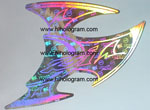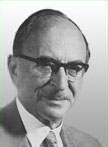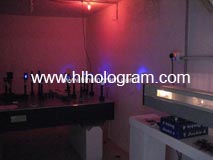Secure Hologram & Hologram Security Features
Holographic Universe Hologram knowledge1 Hologram knowledge2 Hologram knowledge3 Hologram basic
Hologram Basic
The Hologram is based upon Nobel Prize winner Dennis Gabor's theory concerning interference patterns. Gabor theorized in 1947 that each crest of the wave pattern contains the whole information of its original source, and that this information could be stored on film and reproduced. This is why it is called a hologram.
Holography is the only visual recording and playback process that can record our three-dimensional world on a two-dimensional recording medium and playback the original object or scene, to the unaided eyes, as a three dimensional image. The image demonstrates complete parallax and depth-of-field. The image floats in space either behind, in front of, or straddling the recording medium.
The Holographic Universe
The Universe as a Hologram
In 1982 a remarkable event took place. At the University of Paris a research team led by physicist Alain Aspect performed what may turn out to be one of the most important experiments of the 20th century. You did not hear about it on the evening news. In fact, unless you are in the habit of reading scientific journals you probably have never even heard Aspect's name, though there are some who believe his discovery may change the face of science.
Aspect and his team discovered that under certain circumstances subatomic particles such as electrons are able to instantaneously communicate with each other regardless of the distance separating them. It doesn't matter whether they are 10 feet or 10 billion miles apart.
Somehow each particle always seems to know what the other is doing. The problem with this feat is that it violates Einstein's long-held tenet that no communication can travel faster than the speed of light. Since traveling faster than the speed of light is tantamount to breaking the time barrier, this daunting prospect has caused some physicists to try to come up with elaborate ways to explain away Aspect's findings. But it has inspired others to offer even more radical explanations.
University of London physicist David Bohm, for example, believes Aspect's findings imply that objective reality does not exist, that despite its apparent solidity the universe is at heart a phantasm, a gigantic and splendidly detailed hologram.
To understand why Bohm makes this startling assertion, one must first understand a little about hologram. A Hologram is a three- dimensional photograph made with the aid of a laser.
To make a Hologram, the object to be photographed is first bathed in the light of a laser beam. Then a second laser beam is bounced off the reflected light of the first and the resulting interference pattern (the area where the two laser beams commingle) is captured on film.
When the film is developed, it looks like a meaningless swirl of light and dark lines. But as soon as the developed film is illuminated by another laser beam, a three-dimensional image of the original object appears.
The three-dimensionality of such images is not the only remarkable characteristic of hologram. If a Hologram of a rose is cut in half and then illuminated by a laser, each half will still be found to contain the entire image of the rose.
Indeed, even if the halves are divided again, each snippet of film will always be found to contain a smaller but intact version of the original image. Unlike normal photographs, every part of a Hologram contains all the information possessed by the whole.
The "whole in every part" nature of a Hologram provides us with an entirely new way of understanding organization and order. For most of its history, Western science has labored under the bias that the best way to understand a physical phenomenon, whether a frog or an atom, is to dissect it and study its respective parts.
A Hologram teaches us that some things in the universe may not lend themselves to this approach. If we try to take apart something constructed holographically, we will not get the pieces of which it is made, we will only get smaller wholes.
This insight suggested to Bohm another way of understanding Aspect's discovery. Bohm believes the reason subatomic particles are able to remain in contact with one another regardless of the distance separating them is not because they are sending some sort of mysterious signal back and forth, but because their separateness is an illusion. He argues that at some deeper level of reality such particles are not individual entities, but are actually extensions of the same fundamental something.
To enable people to better visualize what he means, Bohm offers the following illustration.
Imagine an aquarium containing a fish. Imagine also that you are unable to see the aquarium directly and your knowledge about it and what it contains comes from two television cameras, one directed at the aquarium's front and the other directed at its side.
As you stare at the two television monitors, you might assume that the fish on each of the screens are separate entities. After all, because the cameras are set at different angles, each of the images will be slightly different. But as you continue to watch the two fish, you will eventually become aware that there is a certain relationship between them.
When one turns, the other also makes a slightly different but corresponding turn; when one faces the front, the other always faces twoard the side. If you remain unaware of the full scope of the situation, you might even conclude that the fish must be instantaneously communicating with one another, but this is clearly not the case.
This, says Bohm, is precisely what is going on between the subatomic particles in Aspect's experiment.
According to Bohm, the apparent faster-than-light connection between subatomic particles is really telling us that there is a deeper level of reality we are not privy to, a more complex dimension beyond our own that is analogous to the aquarium. And, he adds, we view objects such as subatomic particles as separate from one another because we are seeing only a portion of their reality.
Such particles are not separate "parts", but facets of a deeper and more underlying unity that is ultimately as holographic and indivisible as the previously mentioned rose. And since everything in physical reality is comprised of these "eidolons", the universe is itself a projection, a hologram.
In addition to its phantomlike nature, such a universe would possess other rather startling features. If the apparent separateness of subatomic particles is illusory, it means that at a deeper level of reality all things in the universe are infinitely interconnected.
The electrons in a carbon atom in the human brain are connected to the subatomic particles that comprise every salmon that swims, every heart that beats, and every star that shimmers in the sky.
Everything interpenetrates everything, and although human nature may seek to categorize and pigeonhole and subdivide, the various phenomena of the universe, all apportionments are of necessity artificial and all of nature is ultimately a seamless web.
In a holographic universe, even time and space could no longer be viewed as fundamentals. Because concepts such as location break down in a universe in which nothing is truly separate from anything else, time and three-dimensional space, like the images of the fish on the TV monitors, would also have to be viewed as projections of this deeper order.
At its deeper level reality is a sort of superhologram in which the past, present, and future all exist simultaneously. This suggests that given the proper tools it might even be possible to someday reach into the superholographic level of reality and pluck out scenes from the long-forgotten past.
What else the superhologram contains is an open-ended question. Allowing, for the sake of argument, that the superhologram is the matrix that has given birth to everything in our universe, at the very least it contains every subatomic particle that has been or will be -- every configuration of matter and energy that is possible, from snowflakes to quasars, from blu?whales to gamma rays. It must be seen as a sort of cosmic storehouse of "All That Is."
Although Bohm concedes that we have no way of knowing what else might lie hidden in the superhologram, he does venture to say that we have no reason to assume it does not contain more. Or as he puts it, perhaps the superholographic level of reality is a "mere stage" beyond which lies "an infinity of further development".
Bohm is not the only researcher who has found evidence that the universe is a hologram. Working independently in the field of brain research, Standford neurophysiologist Karl Pribram has also become persuaded of the holographic nature of reality.
Pribram was drawn to the holographic model by the puzzle of how and where memories are stored in the brain. For decades numerous studies have shown that rather than being confined to a specific location, memories are dispersed throughout the brain.
In a series of landmark experiments in the 1920s, brain scientist Karl Lashley found that no matter what portion of a rat's brain he removed he was unable to eradicate its memory of how to perform complex tasks it had learned prior to surgery. The only problem was that no one was able to come up with a mechanism that might explain this curious "whole in every part" nature of memory storage.
Then in the 1960s Pribram encountered the concept of holography and realized he had found the explanation brain scientists had been looking for. Pribram believes memories are encoded not in neurons, or small groupings of neurons, but in patterns of nerve impulses that crisscross the entire brain in the same way that patterns of laser light interference crisscross the entire area of a piece of film containing a holographic image. In other words, Pribram believes the brain is itself a hologram.
Pribram's theory also explains how the human brain can store so many memories in so little space. It has been estimated that the human brain has the capacity to memorize something on the order of 10 billion bits of information during the average human lifetime (or roughly the same amount of information contained in five sets of the Encyclopaedia Britannica).
Similarly, it has been discovered that in addition to their other capabilities, Hologram possess an astounding capacity for information storage--simply by changing the angle at which the two lasers strike a piece of photographic film, it is possible to record many different images on the same surface. It has been demonstrated that one cubic centimeter of film can hold as many as 10 billion bits of information.
Our uncanny ability to quickly retrieve whatever information we need from the enormous store of our memories becomes more understandable if the brain functions according to holographic principles. If a friend asks you to tell him what comes to mind when he says the word "zebra", you do not have to clumsily sort back through ome gigantic and cerebral alphabetic file to arrive at an answer. Instead, associations like "striped", "horselike", and "animal native to Africa" all pop into your head instantly.
Indeed, one of the most amazing things about the human thinking process is that every piece of information seems instantly cross- correlated with every other piece of information--another feature intrinsic to the hologram. Because every portion of a Hologram is infinitely interconnected with ever other portion, it is perhaps nature's supreme example of a cross-correlated system.
The storage of memory is not the only neurophysiological puzzle that becomes more tractable in light of Pribram's holographic model of the brain. Another is how the brain is able to translate the avalanche of frequencies it receives via the senses (light frequencies, sound frequencies, and so on) into the concrete world of our perceptions. Encoding and decoding frequencies is precisely what a Hologram does best. Just as a Hologram functions as a sort of lens, a translating device able to convert an apparently meaningless blur of frequencies into a coherent image, Pribram believes the brain also comprises a lens and uses holographic principles to mathematically convert the frequencies it receives through he senses into the inner world of our perceptions.
An impressive body of evidence suggests that the brain uses holographic principles to perform its operations. Pribram's theory, in fact, has gained increasing support among neurophysiologists.
Argentinian-Italian researcher Hugo Zucarelli recently extended the holographic model into the world of acoustic phenomena. Puzzled by the fact that humans can locate the source of sounds without moving their heads, even if they only possess hearing in one ear, Zucarelli discovered that holographic principles can explain this ability.
Zucarelli has also developed the technology of holophonic sound, a recording technique able to reproduce acoustic situations with an almost uncanny realism.
Pribram's belief that our brains mathematically construct "hard" reality by relying on input from a frequency domain has also received a good deal of experimental support.
It has been found that each of our senses is sensitive to a much broader range of frequencies than was previously suspected.
Researchers have discovered, for instance, that our visual systems are sensitive to sound frequencies, that our sense of smell is in part dependent on what are now called "osmic frequencies", and that even the cells in our bodies are sensitive to a broad range of frequencies. Such findings suggest that it is only in the holographic domain of consciousness that such frequencies are sorted out and divided up into conventional perceptions.
But the most mind-boggling aspect of Pribram's holographic model of the brain is what happens when it is put together with Bohm's theory. For if the concreteness of the world is but a secondary reality and what is "there" is actually a holographic blur of frequencies, and if the brain is also a Hologram and only selects some of the frequencies out of this blur and mathematically transforms them into sensory perceptions, what becomes of objective reality?
Put quite simply, it ceases to exist. As the religions of the East have long upheld, the material world is Maya, an illusion, and although we may think we are physical beings moving through a physical world, this too is an illusion.
We are really "receivers" floating through a kaleidoscopic sea of frequency, and what we extract from this sea and transmogrify into physical reality is but one channel from many extracted out of the superhologram.
This striking new Sample of reality, the synthesis of Bohm and Pribram's views, has come to be called the holographic paradigm, and although many scientists have greeted it with skepticism, it has galvanized others. A small but growing group of researchers believe it may be the most accurate model of reality science has arrived at thus far. More than that, some believe it may solve some mysteries that have never before been explainable by science and even establish the paranormal as a part of nature.
Numerous researchers, including Bohm and Pribram, have noted that many para-psychological phenomena become much more understandable in terms of the holographic paradigm.
In a universe in which individual brains are actually indivisible portions of the greater Hologram and everything is infinitely interconnected, telepathy may merely be the accessing of the holographic level.
It is obviously much easier to understand how information can travel from the mind of individual 'A' to that of individual 'B' at a far distance point and helps to understand a number of unsolved puzzles in psychology. In particular, Grof feels the holographic paradigm offers a model for understanding many of the baffling phenomena experienced by individuals during altered states of consciousness.
Creation - Holographic Universe - 2
In the 1950s, while conducting research into the beliefs of LSD as a psychotherapeutic tool, Grof had one female patient who suddenly became convinced she had assumed the identity of a female of a species of prehistoric reptile. During the course of her hallucination, she not only gave a richly detailed description of what it felt like to be encapsuled in such a form, but noted that the portion of the male of the species's anatomy was a patch of colored scales on the side of its head.
What was startling to Grof was that although the woman had no prior knowledge about such things, a conversation with a zoologist later confirmed that in certain species of reptiles colored areas on the head do indeed play an important role as triggers of sexual arousal.
The woman's experience was not unique. During the course of his research, Grof encountered examples of patients regressing and identifying with virtually every species on the evolutionary tree (research findings which helped influence the man-into-ape scene in the movie Altered States). Moreover, he found that such experiences frequently contained obscure zoological details which turned out to be accurate.
Regressions into the animal kingdom were not the only puzzling psychological phenomena Grof encountered. He also had patients who appeared to tap into some sort of collective or racial unconscious. Individuals with little or no education suddenly gave detailed descriptions of Zoroastrian funerary practices and scenes from Hindu mythology. In other categories of experience, individuals gave persuasive accounts of out-of-body journeys, of precognitive glimpses of the future, of regressions into apparent past-life incarnations.
In later research, Grof found the same range of phenomena manifested in therapy sessions which did not involve the use of drugs. Because the common element in such experiences appeared to be the transcending of an individual's consciousness beyond the usual boundaries of ego and/or limitations of space and time, Grof called such manifestations "transpersonal experiences", and in the late '60s he helped found a branch of psychology called "transpersonal psychology" devoted entirely to their study.
Although Grof's newly founded Association of Transpersonal Psychology garnered a rapidly growing group of like-minded professionals and has become a respected branch of psychology, for years neither Grof or any of his colleagues were able to offer a mechanism for explaining the bizarre psychological phenomena they were witnessing. But that has changed with the advent of the holographic paradigm.
As Grof recently noted, if the mind is actually part of a continuum, a labyrinth that is connected not only to every other mind that exists or has existed, but to every atom, organism, and region in the vastness of space and time itself, the fact that it is able to occasionally make forays into the labyrinth and have transpersonal experiences no longer seems so strange.
The holographic prardigm also has implications for so-called hard sciences like biology. Keith Floyd, a psychologist at Virginia Intermont College, has pointed out that if the concreteness of reality is but a holographic illusion, it would no longer be true to say the brain produces consciousness. Rather, it is consciousness that creates the appearance of the brain -- as well as the body and everything else around us we interpret as physical.
Such a turnabout in the way we view biological structures has caused researchers to point out that medicine and our understanding of the healing process could also be transformed by the holographic paradigm. If the apparent physical structure of the body is but a holographic projection of consciousness, it becomes clear that each of us is much more responsible for our health than current medical wisdom allows. What we now view as miraculous remissions of disease may actually be due to changes in consciousness which in turn effect changes in the Hologram of the body.
Similarly, controversial new healing techniques such as visualization may work so well because in the holographic domain of thought images are ultimately as real as "reality".
Even visions and experiences involving "non-ordinary" reality become explainable under the holographic paradigm. In his book "Gifts of Unknown Things," biologist Lyall Watson discribes his encounter with an Indonesian shaman woman who, by performing a ritual dance, was able to make an entire grove of trees instantly vanish into thin air. Watson relates that as he and another astonished onlooker continued to watch the woman, she caused the trees to reappear, then "click" off again and on again several times in succession.
Although current scientific understanding is incapable of explaining such events, experiences like this become more tenable if "hard" reality is only a holographic projection.
Perhaps we agree on what is "there" or "not there" because what we call consensus reality is formulated and ratified at the level of the human unconscious at which all minds are infinitely interconnected.
If this is true, it is the most profound implication of the holographic paradigm of all, for it means that experiences such as Watson's are not commonplace only because we have not programmed our minds with the beliefs that would make them so. In a holographic universe there are no limits to the extent to which we can alter the fabric of reality.
What we perceive as reality is only a canvas waiting for us to draw upon it any Sample we want. Anything is possible, from bending spoons with the power of the mind to the phantasmagoric events experienced by Castaneda during his encounters with the Yaqui brujo don Juan, for magic is our birthright, no more or less miraculous than our ability to compute the reality we want when we are in our dreams.
Indeed, even our most fundamental notions about reality become suspect, for in a holographic universe, as Pribram has pointed out, even random events would have to be seen as based on holographic principles and therefore determined. Synchronicities or meaningful coincidences suddenly makes sense, and everything in reality would have to be seen as a metaphor, for even the most haphazard events would express some underlying symmetry.
Whether Bohm and Pribram's holographic paradigm becomes accepted in science or dies an ignoble death remains to be seen, but it is safe to say that it has already had an influence on the thinking of many scientists. And even if it is found that the holographic model does not provide the best explanation for the instantaneous communications that seem to be passing back and forth between subatomic particles, at the very least, as noted by Basil Hiley, a physicist at Birbeck College in London, Aspect's findings "indicate that we must be prepared to consider radically new views of reality".
Creation
By Ellie Crystal
Reality is a projected illusion - or Hologram - created by consciousness thought.
It all begins with a tone and a pulse of light that separates in 12 pyramds around 1 - forming a matrix or grid of sound, light and color. This creates a grid which projects the illusions of realities on difference frequency levels.
The creational Hologram is based on mathematics that repeat in cycles called time. We refer to this as Sacred Geometry - the blueprint of our hologram.
The Hologram is not stationary. It is based on spiraling light and thought and is forever in flux.
I believe we were created an an experiment in Linear Time and Emotions - based on electromagnetic polarities that keep our consciousness within the grids of the illusion. We were created to experience within what one could perceive of as an program.
There is a beginning and there will be an abrupt end - the end we sense as an explosion. Yet it is nothing more than the close of the holographic program and the lifting of consciousness from its confines.
Mankind has always pondered the origin of its creation as that is part of our DNA codings to search and quest for a way home.
By its very creation - the Hologram can be explained by physics as we come closer to the truth. Reality and the illusion are all about physics and math.
Many people are of the theory that reality is a hoologram. I am not alone. Neither are you.
Holograms
Holograms cannot be counterfeit? Some companies will make counterfeit hologram too if your hologram is not complicated and without high security hologram feature.
Information reference source from Hologram Manufacturer , www.hlhologram.com, www.IHMA.org, www.securityhologram.com
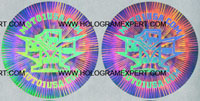
Hologram Labels
Hologram Product
hologram labels are very widely demanded as they play a vital role for security in almost all conceivable sectors in the market from OEMs to distributors and retailers. Hologram labels are easy to use and are a very cost effective solution against duplication. These labels when affixed on the desired place provide a direct visual means for the final customer to verify the genuineness of the product. Today, it is seen that that the public universally accepts as proof of authenticity only those products with hologram labels depicting depth, color and movement in an imprint. The hologram is irreplaceable in the current battle against counterfeit merchandise. Many manufacturers supply hologram labels in sheets for manual application and in reels for automatic machine application.
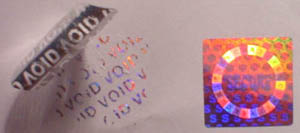
Advantages of Hologram Labels
Hologram labels have certain advantages which are not available in ordinary printed labels. These are as follows:
- Hologram labels cannot be copied.
- They cannot be altered.
- They cannot be adapted or manufactured cheaply from scratch.
- Hologram labels are also unique as they are able to provide covert (hidden) identity and overt (visual) identity embedded within the same area of the space printed.
- From a purely branding and impact point of view, hologram labels affixed on any packaged product extends much more shelf-appeal and adds greatly to consumers' perception of quality.
Benefit of Polyester and Acetate Hologram Labels
Polyester hologram labels use a selective release which leaves a pattern of dots as shown below:
Acetate hologram labels are frangible. They will tear when an attempt is made to remove them as shown below:
Uses of Hologram Labels: Hologram labels are used to protect high-value, high-volume products and equipment from the increasing worldwide risk of counterfeit. Accordingly, hologram tamper evident labels are used for:
- authentication label for identification
- authentication label for collectibles
- authentication label for documents
- authentication label for packaging etc.
Applications of hologram labels
Hologram labels are used in many products like as follows:
- Company ID cards
- Membership cards
- Artwork
- Coins
- Autographed & licensed products
- Gift certificates
- Bank checks
- Product Packaging for brand protection.
- Parking Passes
- Driver's license
- Pharmaceuticals
- Cigarettes and alcohol
- Clothing
- Cosmetics etc.
Hologram Label Options
- The minimum application temperature is +35F to apply labels.
- The application surface should be clean and dry.
- After application, the service temperature range of hologram label is -50F to +200F.
- Polyester hologram labels are suireference for indoor and outdoor applications.
- If an ID card printer is used to printing ID cards , the hologram label should be applied after the card is printed. If the label is applied before printing, it will affect the printing quality and damage the print head.
- Hologram labels can also be applied on the finished card after heat sealing.
Hologram stickers
Information reference source from Hologram supplier and www.IHMA.org
Hologram stickers are widely used for various security and branded purpose. Hologram stickers are very popular and more demanded compared to other visual mediums that represent images on a two-dimensional surface because they are able to depict objects that are holographed with an added dimension of depth. Every detail on a hologram or hologram stickers from its depth to the textures is produced using coherent light sources like laser beams or electronic beams. Hologram stickers are today used to carry a variety of messages in a wide array of shapes, sizes and forms across a large spectrum of products and objects.
Most hologram stickers are self-adhesive tamper-evident security hologram stickers providing authentication, security and protection against counterfeit.
Types of Hologram stickers
- DOT-MATRIX Holographic sticker
In Dot-Matrix Hologram, there are unlimited computer controlled and laser beam engraved dots. Each dot depicts a separate diffraction grating. They create a beautiful impact of variable images on a single sticker. Dot-matrix Hologram stickers can have lots zooming, moving, flipping effect etc. which add to their popularity.

- True Color Holographic sticker
True Color Holograms are those holograms that are made up of photographic quality artwork. These stickers are highly demanded because they are a very good way to achieve anti-counterfeit performance. This is because they cannot duplicate or copy hologram sticker close to original one if they do not get the original photo.

-
- Flip-Flop Holographic sticker
Flip-Flop hologram has the unique property of displaying two images from two different viewing angle. In other words, when the viewing angle changes left to right (horizontally) or upside and down (vertically), different images emerges through the hologram. One hologram image will be hidden and another hologram image will display when the view angle is changed.
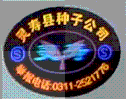

- Kinetic movement sticker
Like flip flop hologram, Kinetic movement hologram stickers can also be seen from different viewing angle. These hologram stickers are made both by 2D/3D and dot-matrix type hologram.

- Combination of Holograms
Combination holograms can be used to make stickers that create an impact that not only has extra-ordinary viewing effects but also security features. Usually, it is recommended to combine 2D/3D and dot-matrix types which can have the advantages of both the sharp kinetic movements of dot-matrix and the depth of 2D/3D holograms into the stickers.
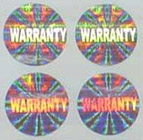
- 2D/3D Hologram stickers
These hologram stickers are made up of multiple two dimension layers. The images are visually placed one over the other with visual depth which produce an effect of three-dimensional structure on the stickers. The stickers have very good visual depth between different layers and shininess on the first layer.
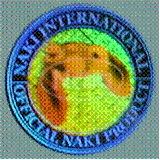
- 2D Hologram stickers
These stickers are made up of two dimension images. The images are given various colors and position in one layer. The sicker has one layer on hologram image without visual depth.

- Micro text or image sticker
These hologram stickers can be clearly seen by magnifier and difficult to be seen clearly by naked eye.
- Transparent hologram sticker
These are see through type stickers, pasted onto documents. Then text under hologram image can be seen through transparent holographic sticker
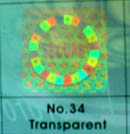
Properties of Hologram stickers
- Pressure tamper evident holographic sticker:
These stickers are damaged when they are removed. The holographic image is easily destroyed under pressure when the sticker is teared off and then the sticker cannot be reused again.

- Different Color or Thickness of Holographic sticker:
Various color options are available like metalized film, silver, gold, blue, green etc. However, the most popular colors are usually silver color or golden metalized color. The stickers are also available in varied thicknesses. The thicker the material, the heavier is the sticker , and hence a little more expensive than the thinner sticker.

- Hidden Text or Image
hidden text or image feature on a hologram sticker means an unique encrypted image or text, which is invisible to the naked eye but is detecreference by means of a pocket laser reader.
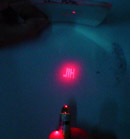
- Serial Number Hologram sticker
Serial numbers on hologram stickers are extra security feature. They improve management of goods and provide anti-counterfeit ability by pasting each hologram sticker onto the package of goods.


- Overprinting Release
Overprinting released hologram stickers leaves a black overpriting word 'VOID' after the sticker is peeled off. It can also be in other colors.
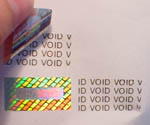
Applications of Hologram stickers
Hologram stickers are used to enhance brand image & security in various types of industries. stickers are used as a very attractive and viable option in product packaging and security applications. Hologram stickers find application in industries & sectors as listed below. The list of application of hologram stickers is growing day-by-day.
- Chemicals / Detergents, Fertilizers, Seeds
- Fine Jewelry / Watches
- Building Material / Hardware
- Aircraft/ Automotive & High Technology/Engineering Spares & Machine Parts
- Sporting goods, Toys, Gifts/novelties
- Electrical/ Electronic Appliances & Components
- Recording Media
- Clothing Hang-tags
- Branded fashion wear & Accessories
- Driving Licenses
- Certificates
- Confidential Documents & Envelopes
- Security, Bonds, Fsinancial & Share Certificates
- Bank Cheques
- Drafts & Guarantees
- Loyalty / Vouchers/ Reward /Passes
- Credit Cards/ Membership/ ID cards
- Computer Peripherals
- Stationery Products
- Automotive Components
- Passport
- Excise Revenue Stamps etc.
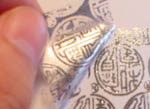
Types f Hologram
Reflectin Hologram, Transmissin Hologram, Embssed Holograms, Integral Hologram, Rainbow Holograms, Computer Generated Holograms, Multiplex Hologram, Steregram Hologram, Vlume Holograms, Plane Holograms
General Infrmatin
A Basic Idea Abut Hologram, A Histry f Cmmercial Holograms, Benefits f Hologram
Holography Technlgy, Holography Masters, Manufacturing Prcess f a Hologram, Applicatins of Hologram
Applications of Hologram
Ever since its commercial usage in the 70's, there is no looking back for holography and hologram products. The demand has only manifolded with each passing year. Holography has found its applications in almost all industrial sectors including commercial & residential applications. There is no doubt about the fact that in few years from now, you will see a new world of holograms in every aspect. The use of holograms is the representation of a new visual language in communication, where we are moving into the age of light as the media of the future. Holography will soon be an integral part of the light age of information and communications.
Security
One of the fastest and the most popular growing area for the use of holograms is the security and product authentication. The presence of holograms indicates the authenticity of these items. They provide a powerful obstacle to counterfeiting. The security holograms have proven to be unsurpassed when added to documents, anti-counterfeiting, tamper-proofing, customizing ticket protection, identification documents including credit and phone cards, drivers licenses etc. The trend that almost all credit cards carry a hologram is a good sign that security holography has proven to be very effective.
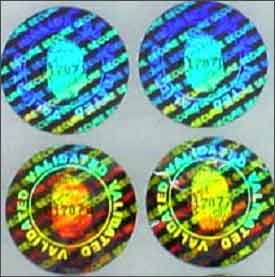 An example:
An example: Since their incorporation on Visa payment card and Master card in the early 1980s, holograms have become one of the most common public security features on branded goods and value documents.
Entertainment
Holograms have also proven effective in the entertainment industry. Various Hollywood movies, specially the science fiction films, have used holographic special effects. Even movie posters are made holographic. Holograms are also used as promotional tools on records and CD covers.
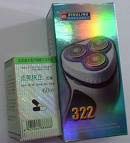 An example:
An example: Some popular movies using holographic effects are like Star Treks' Holo deck, Star Wars' Princess Laya, Hologram Man and Escape from LA etc.
Packaging (Consumer Goods Brand Protection)
This is one area where holograms have become popular . Hologram packaging includes flexible packaging, board packaging, rigid box, pack packaging etc. The holographic packaging provides eye catching visual impact, authentication, and added value. In reality, all products are subject to counterfeiting. Hence proper holographic packaging on consumer goods serve an important way for brand protection.
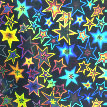
 An example:
An example: Brach & Brock Candy Company projected a three-fold increase in sales using holographic packaging.
Promotional
Holograms are widely used for promotional purpose. The use of hologram completes the packaging, the promotional activities associated with your product and add some attraction towards it. It is widely demanded because it enhances company's image and some shelf appeal also.
An example: You open your favorite magazine and find a 3D image of the new BMW roadster driving right off the page and into your room. This is new age hologram.
Gifts
Today holographic products have become important gift items for corporates as well as individuals. The holographic gifts serve as important way to enhance brand image. For many, holographic items are rare collectibles which they can treasure for a lifetime.
Point of Purchase Advertising
An example: You walk into a shoe store and see a larger than life-size, complete-color image of the latest Nike shoe hovering before your eyes. It rotates so that you get a proper view from the front and side. That is the power of New Generation hologram. It makes things look real.
Tax Stamp
As a security devise, holograms are widely used on tax stamps of many countries. Tax stamps are issued by governments principally on alcohol and tobacco to ensure duty is paid and to distinguish genuine products from fakes. There are two varieties of holographic tax stamp—hologram tax stamp with security paper and only hologram with or without serial no.
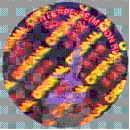
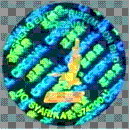
Display
Display holography use all types of holograms from decorative foils to display holograms to eye catching stereograms. Display holography is used in point of purchase, corporate display, trade show. They use various holograms , including large format holograms for their dramatic effect.

An example: A hologram was used in Continental Tire's in-store display, which received highest ever dealer response.
Labels & Tapes
Holograms are also used in labels, tapes and stickers. They are provided with a self adhesive backing. They are also provided as hot stamping foil. Label applications include direct mail, promotional products, advertising pieces, and point purchase displays.
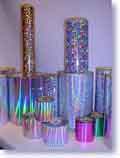
An example: Sales increased when Wardley fish food used holographic labels on their products.
Medical Applications
Holographic technique is also used in various medical applications like CAT scans, X-ray, MRI, Ultrasound, opthalmology, endoscopy, otology, orthopedics and many more.
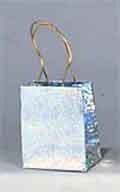
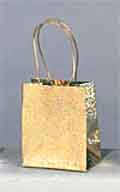
Decoration
Another main application of hologram is in decoration. With its glitter color changing effect, multi-channel visual enhancement, the packaging with hologram foil, holograms are sure to attract the customer and increase the visual value of products inside.
An example: Blanton Whiskey added a hologram to its bottle and this led to an instant and increased sale .
Art and Interactive Graphics
Art and Interactive Graphics is a very special area of holography, comprising is the most exciting area for printing. Holography is an art in itself as it deals with making some kind of visuals. By using holographic effects for the background of over printing lithography, some of the in-store lighting problems of holograms can be overcome. Color printing combined with holography form stunning interactive visual effects.
B2B E-Commerce: Engineering, Architecture & CAD/CAM
You can enhance design visualization by using a New Generation Hologram in computer-generated three-dimensional images, CAD/CAM designs. That is why holograms are widely preferred by professional users, such as architects, engineers, production companies.
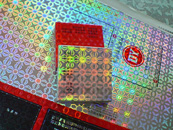
Sports Events
Holograms have become a common and a regular feature of the world’s premier sporting events. These are used to protect event tickets, event merchandise, and also accreditation programs.
Professional Photographers
Professional photographers can also use holographic technique as add-ons or alternatives to regular two-dimensional portrait photography products.
Holographic Interferometry
This is also a very important holographic technique for measuring changes in the dimensions of an object. This technique is useful in industrial stress analysis, quality control etc.
IT consumables
Lots of the IT consumables use hologram on its package and opponent for security and logistic.
Optical Devices
Holographic lenses, diffraction gratings are optical devices in which the "object" is a mirror or a lens. They can be used to perform more specialized functions like making the panel instruments of a car visible in the windshield for increased safety.
Benefits of Hologram, Holograms and holographic products are today widely used in any and every industry to enhance the image of their brands as an genuine and authenticated brand in the market. Since holograms are almost impossible to counterfeit, they are widely used for security applications. They are also used in attractive product packaging, fancy gifts, 3-D art, registration of artifacts, new technology aircraft, automobiles, etc. Because of its applicability in various applications, holograms are widely demanded.
Why should holography be used?
The reasons for using Hologram and holographic products are as follows:
- Pass Around Value: Since holograms have impressive appearance, it is likely that people will bring them to top notice of colleagues and associates.
- Impact: It is a known fact that holograms are looked at significantly and longer than other graphic mediums because they are eye-catching. Any name or logo or slogan on the hologram has greater impact and the message is enforced.
- Security: Holograms are widely used for security purpose. It is not possible to to duplicate holograms and hence they have become an essential part of many government and commercial security programs. Holograms are applied to documents, ID cards, currency, and product labels.
- Retention: Holograms are certain objects which can be treasured for a long time which is not the case with another object, be it a pen or a calendar or a diary.
- Commercial Purpose: Commercially, holographic products, comprise a very unique market in themselves. They are sold as retail products in the market . Various products like greeting cards, direct-mail literature, trading cards, collectibles, packaging and displays etc. have holographic images.
- Promotional Purpose: Holographic products have great promotional effects as they diffract the seven colors of the spectrum when the light falls on them and create an unique three-dimensional image. Once applied to the product, the apparent value of the product is automatically enhanced no matter which way you look at it.
Benefits or uses of holograms
Some popular benefits or uses of holograms can be summarized as follows:
- Holograms combats counterfeiting.
- They cannot be reproduced.
- They provide product authentication.
- They minimizes document tampering
- Holograms are quick and easy optical validation.
- They enhance packaging appeal and increase brand sales.
Applications of Holograms
Holograms are used in various products like as follows:
- Currency
- Credit Card
- Legal Document
- Government Document
- ID Badge
- Stock Certificate
- Passport
- Prescription Pad
- Automobile Registration
- Drivers License
- Branded Products
- Collectibles
- Warranty Seals
- Apparel
- Liquor
- Tickets
- Gift Certificates
- Stamps etc.
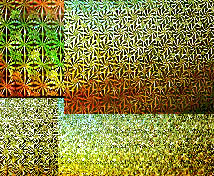
Computer Generated Holograms
Source from: http://en.wikipedia.org/wiki/Computer_Generated_Holography
The computer generated holograms are holograms which give the appearance of binary representation of interferogram. Such holograms are produced with the help of computer and hence the name. Computers are used to scan, design, enhance and create images and patterns for developing 2D and 2D/3D holograms. These images, often cannot exist in the real world. This is a powerful technology suireference for a wide range of display types which includes 2D, auto stereoscopic, stereoscopic, volumetric, and true 3D imaging. Although computer based holograms are currently expensive for many applications, they will become a viable alternative in the near future.
How is a computer generated hologram created?
To make a computer generated hologram (CGH), the image of the object is first taken. The background of the image is then removed. Whitespace is added around the object which helps in obtaining higher transmission. There are three basic elements in holography. These are the light source, the image and the hologram. It is to be noted that if any two of these are known or predetermined, then the third one can be computed. For example, if we have two elements, say a parallel beam of light of certain wavelength and a "double-slit" system or a simple "hologram", the third element, that is diffraction pattern can easily be calculated. Similarly, if we know the diffraction pattern and the details of the double-slit system, the wavelength of the light can be calculated. This is the basic idea behind the computer generated hologram-we can dream up any pattern we want to view. In other words, once we decide what wavelength we want to use for observation, we can design the hologram by a computer. This computer generated hologram is growing rapidly.
Uses of computer generated hologram
- CGH is used in the making of holographic optical elements (HOE) for various purposes like scanning, focusing & splitting.
- CGH is used for controlling laser light in many optical devices like a common CD player.
- Computer generated holograms are usually light weight .
- CGHs can create wavefronts of arbitrary complexity.
Applications of computer generated hologram
Computer generated holograms are attractive and used in variety of applications to provide three dimensional views of an object. Some of the applications are as follows:
- Product packaging
- Packaging films
- Gift boxes
- Packaging foils
- Cartons
- Promotional labels and stickers
- Attractive for applications like optical data processing and optical testing. etc.
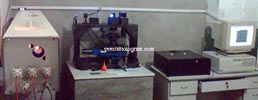
Counterfeiting Holograms & Preventing It
Soure from http://en.wikipedia.org/wiki/Holography Hologram supplier and www.IHMA.org
Holograms have been considered to be an effective way for protecting products and enhancing their authenticity. Holograms are used by almost all companies from the food, automotive and pharmaceutical industries to the manufacturers of spirits, documents, confectionery, audio and video products etc. We consider holograms as uncounterfeireference. However the truth of the matter is that there there are still some ways to counterfeit holograms which are used in security. Commercial hologram designs can be counterfeited.
How to prevent counterfeiting in holograms
Source from Hologram supplier and www.IHMA.org
Though there is no such proof that holograms can be counterfeited, it is always better to believe in the slogan "prevention is better than cure". Some researchers have come up with some effective measures to combat counterfeiting in holograms.

These are as follows:
- Hidden information or complex images: One method that can prevent counterfeiting is by including hidden information or by making the image so complicated that it is not worth to duplicate it, considering the time and money involved. Hidden information is of great value only if the cheater cannot find it or duplicate it. So, effective use of hidden information or any kind of complex images requires some sort of relatively simple and inexpensive reading device or decoding device.

- Variable processing parameters: This is one way which is extremely difficult to copy using either one-step or two-step copying. The method is to randomly change the exposure, development time or other processing parameters to produce variable shrinkage all over the hologram. This results into a hologram whose color varies from point to point. Because a laser is monochromatic, the brightness of a variable-shrinkage hologram changes dramatically with the shrinkage of the film. In fact, if the film is thick enough or the shrinkage is extreme enough, the copy in most of its regions will have no image at all.
- Variable Information: Holograms are not easy to counterfeit if they include variable information like serial numbers, encoded personal information or dates. It is possible to record variable information on holograms while applying holographic hot stamping foil to a substrate.
- Special Materials: Another method for complicating the optical copying process is to make the hologram of some special materials which alter the polarization of light or selectively scatter particular wavelengths of light or else the hologram can be over coated or laminated under such materials.
- Multiply-Connected Holograms: Another effective approach to preventing mechanical copying of holograms is to make the holograms multiply-connected which means that the hologram is composed of dots or else is punched full of holes.
- Combined Countermeasures: All the methods mentioned above may not be the perfect solutions for preventing counterfeiting. In such cases, combined countermeasures or countermeasures used in combination can be highly effective against all of the counterfeiting methods.
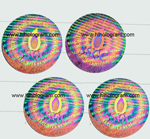
There are many methods for counterfeiting security holograms. Though there is no indication whether these methods have been used by counterfeiters or not in the security field, the advancement of holographic technology and the high level of activity in the field will definitely lead to hologram counterfeiting. In the commercial sector, hologram counterfeiting have been occurring in recent years. Hence importance should be given in this area by adopting various methods to fight against counterfeiting on holograms.
Digital Hologram
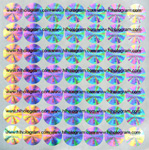
Source from http://en.wikipedia.org/wiki/Digital_holography
With the coming of high-quality megapixel digital cameras, the creation of digital holograms of real-world objects has become viable today. A hologram is an optical element or an image that can record all information present in a wave front-both amplitude and phase information. In other words, a hologram can reproduce the complete 3D wavefront of a captured image or object . The process of making hologram is known as holography and a sub area of holography is the digital holography. The hologram formed using digital holography is called digital holograms. Digital holograms are used to provide three-dimensional (3D) information of a scene or object. Digital cameras capture images which record the intensity of an optical wavefront. With digital holography, the recording of the intensity and directional information of an optical wavefront is possible, which in turn encode some 3D information about the objects we capture.
Difference between digital holograms and computer generated holograms
The difference between the digital holograms and the CGHs is that in digital holograms, there are a group of digital images synthesized by controlling fractal parameters, which at the same time depict intrinsic relationship and distinction. These holograms reveal the correlation properties between part structure and whole structure, and also between some stages and entire process of scenes.
Process of making digital holograms
Also known as synthetic holography, digital holography, simulates the recording process of optical holography. Depending on the diffraction theory, the wave fronts scattered by objects are synthesized and analyzed by using computers. These objects are numerically specified or by means of mathematical models. During recent years, many interesting results have been achieved in digital holography owing to improvements in computer architecture, computational methods, and electro-optical technology. Digital holograms are a series of computer-generated images in sequential order and these images do not require to record the light distribution of the objects, unlike optical holograms. The research work of digital holograms is mainly inclined towards formation and rendering of images. It is possible to reconstruct the imaginary objects that do not exist physically in digital holography. Digital holograms are initially saved as a file directly and using a computer program they are reconstructed. They are simpler to record and reconstruct, but resolution is much lower than a holographic film.
The content for digital holograms can easily be produced by non-experts, and the printing process is comparatively inexpensive. Usually a three-dimensional graphical scene, a series of digital photographs or a short movie of a real object is enough for producing digital holograms.
An example: A diagrammatic representation of a digital hologram of a car headlight with integrated CAD data.
The above figure shows a digital color white-light reflection hologram of a car headlight. It was formed by taking 360 perspective photographs from different angles. The photographs were multiplexed into different sub-zones. Subsequently, three different partial views (rear, side and front) are observed by moving within the total viewing zone of 110 degree. After calibrating the projector and registering the holographic plane, interactive graphical elements like wire-frame or shaded CAD data can be integrated into the hologram.
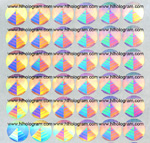
Advantages
Compared to a conventional optical holography, digital holograms have many advantages. These are as follows:
- Digital holograms have strong anti-disturb property.
- They are easy to be modified.
- They are difficult to be imitated.
- By using the pixel holograph and embossment, hologram films can be fabricated by transforming digital holograms. This can make digital hologram anti-counterfeiting identifiers.
- Digital holography uses holographic printers, exposing the photosensitive emulsion with computer generated images. This leads to the creation of conventional holograms with digital content rather than real scenery.
- 2D/ 3D graphics or digital photographs and movies can be printed which helps in the holographic recording of real outdoor scenes, completely synthetic objects, and objects in motion. This is impossible to achieve with optical holography.
- Digital holograms can be multiplexed.
- Another basic advantage is that the content for digital holograms can easily be created by non-experts and the printing process is not very expensive compared to conventional holograms.
- A series of digital photographs or a short movie of a real object is enough for producing digital holograms.
Display Hologram, Display holograms are widely used as a powerful tool wherever an audience needs to be reached. They are popular and used frequently for eye-catching displays at trade fairs or presentations-a truly unique and amazing way to present objects, corporate images, educational materials and many more. This type of hologram is recorded on to a photographic glass or film plate. The photograph of a virtual object reproduces real 3D magic in display hologram. Display holography is basically a large-scale holography which can play a vital role to get the impact and attention you have been seeking. As it is, we all know that holograms are used for that "extra" effect and look, and display holography enlarges this effect many times over. If you need to grab a anyone's attention then display holography is your all-time solution.
Advantages of display hologram:The striking three dimensional properties of holograms make them ideal for displays. Display holograms can produce spectacular displays for educational, medical, scientific, artistic and commercial purposes. Holographic displays have one great advantage of avoiding the risk of theft of art objects. The same object can be displayed at several places at the same time, which in turn implies that there is much wider exposure of rare items.
Selection guide: Requirement of a Display Hologram
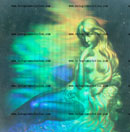
Source from: http://www.hololight.net/display.html
An ideal display hologram should meet certain requirements, such as follows:
- White Light Viewable Image: The display holograms should be preferably viewed with a light source which is white. Finite size of the source creates blur in the image. When we talk about a typical white light source, it is the sun. The sun light is equivalent to the case of reconstructing a hologram from a distance or length of one meter using a white light source of 9 mm diameter. The blurred image is around 0.6 mm for an image point at distance of 10 cm from the hologram. In other light sources, the apparent size of the source can be reduced.
- Focused Image: When the hologram is viewed by a white light source, the image should appear to be well focused. The image is blurred due to the finite size of the source and its spectral bandwidth. The blurring of the image increases with the increase in the distance of the image point from the hologram. The average distance of the image from the hologram can be minimized. This is done when the image straddles the hologram plane.
- Wide Field-of-View: The field-of-view of the hologram should be wide to allow a large parallax. The vertical field-of-view may be restricted but the horizontal field must be large.
- High Resolution: The display hologram should produce an image with excellent sharpness.
- Low Image Aberrations: The image of the display hologram must be aberration free and without distortions. The image should not move as the observer moves up or down or sideways in the field.
- Low Background Noise: Background noise has a drawback of reducing the contrast of the image. The processing chemistry should not introduce scattering noise. Background noise (flare light) is also introduced by Interference between light scattered by different parts of the body.
- True Color: The display hologram should produce the image with true color. For monochrome object, while a display with only one color gives satisfactory results for many purposes, the addition of false colors can improve the display.
- Ambience: Another important requirement is that hologram should display the image as acceptably bright-with proper contrast in high ambient light brightness.
- Hologram Durability: The display hologram medium should be resistant to
Applications of digital holography
The applications of digital holograms can be seen in the following areas:
- Holographic optical elements (HOEs): Holograms are used as lenses.
- Holographic interferometry: To detect form deformations.
- Optical data storage: In the area of security applications.
- They have a good application prospect in laser holography anti-counterfeiting field.
- 3D displays
- Optical data processing.
Embossed Holograms
Source reference from: http://www.holokits.com/a-Types_of_holograms.htm and WWW.IHMA.ORG
etween the reflection and transmission types of holograms, many variations of holograms can be made. One such popular variation is the embossed hologram. Embossed holograms are the type of holograms used widely in most security applications. They offer an effective method of protection against any forms of manipulation, as they are too difficult to copy due to their complex technical structure. Almost all credit cards and passports have embossed hologram. One of the most common example of an embossed hologram is the "eagle" in any Visa card. These holograms are easily produced in mass quantity at a very low cost. Embossed holograms have become very popular for various purposes, like advertisement, promotion, security labels, plastic cards etc.
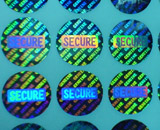
Properties of embossed hologram
Some important properties of embossed hologram are as follows:
- Embossed holograms have shallow hologram depth. The depth is usually a few millimeters.
- The cost per unit when mass-produced is very low.
- Embossed holograms are durable and flexible.
- One of the peculiar feature of embossed hologram is that mass production can use existing equipment and technology, like in CD production.
Process of making embossed hologram
Embossed hologram is a kind of white-light transmission hologram which is applied to a reflecting relief surface. This helps in diffracting light. In the first place, a transmission stereogram is printed on a light-sensitive medium. This medium is engraved to form a microscopic relief pattern that is similar to the interference pattern of the holographic image. When developed, the hologram is made up of grooves on the surface. A layer of nickel is coated on this hologram and then peeled off, which results in a metallic "shim." In the same manner, various secondary shims are produced from the first one. The shim is placed on a roller. On account of high temperature and pressure, the shim presses or embosses the hologram onto a roll of composite material. Embossed holography is a technique or a process which mechanically copies holograms for mass production. These embossed holograms diffract incoming white light into rainbow colours and simultaneously reconstruct the holographic image. They are also called rainbow-holograms at times.
Applications of embossed hologram
Embossed holograms are used in a wide variety of applications such as follows:
- Packaging films
- Paper
- Decorative laminate
- Foils
- Labels
- Automatic labeling
- Screen printing
- Window patching
- Security applications specially on visa cards etc.
What are needed to produce embossed holograms?
- Graphics artwork like for example, company logos, texts, images for 2D/3D-holograms.
- Three-dimensional objects in scale of 1:1 for 3D-holograms.
- Specially produced film-sequences and computer-animations for holographic stereograms.
Advantages of embossed hologram
- Embossed holograms have a decisive cost advantage for large-volume applications like in credit cards and telephone cards.
- They can be applied by hot stamping.
- These holograms are thin enough to be used on thin, flexible items like paper currency and travelers' checks.
- The greatest advantage of embossed holograms in some applications is the fact that they are more durable than other holograms.
- The embossed holograms provide the benefit of multiple colors.

Disadvantages of embossed hologram
- The production of an embossing master is very time-consuming.
- The production of embossed hologram is a relatively expensive process.
- The major disadvantage of embossed hologram is that it lack depth.
Future of Holography Technology
"You'll be walking around in downtown London and be able to see the shops, the stores, see what the traffic is like. Walk in a shop and navigate the merchandise, not in the flat, 2D interface that we have on the web today, but in a virtual reality walk through." - Bill Gates, 2005
Introduction
Source from: http://www.pauladawson.com.au/holo.html
The word hologram is derived from the Greek words "holos" meaning whole and "gamma" meaning message-in other words, holograms depict whole message. Holograms appear to contain a three-dimensional image under proper illumination. They cannot be copied by ordinary means and hence are widely used to prevent counterfeiting of documents such as credit cards, driver's licenses, admission tickets and many other products.
Current applications of holographic technology
Today, the most popular use of holograms is in consumer products and advertising materials. Holograms are also important in various other areas of scientific research, medicine, commerce and industry. We below a list of current holographic applications in various fields:
- Holograms are used in consumer packaging of products and advertisement to attract potential buyers.
- Holograms are used on magazine/book cover. For example: One of the most memorable Sports Illustrated covers till date was the December 23, 1992 issue featuring Michael Jordan.
- Holograms are also used on sports trading cards.
- Hologram usage on credit cards, debit cards, I-cards, license etc. provide added security to minimize counterfeiting.
- Holography is also used to make archival recordings of valuable and fragile museum artifacts.
- Researchers and industry designers use holographic interferometry to test and design many things like tires, engines to prosthetic limbs and artificial bones and joints.
- Holographic lens system to read bar codes is widely seen in supermarket and department store scanners.
- Holographic optical elements (HOE's) are used while navigating by airplane pilots. In some military aircraft, pilots while looking through the windshield can read their instruments by using a holographic display projected in front of their eyes. This feature is available on some models of automobiles as well and this is depicted below.
- Holographic technology is used in medical science in the form of MRI, CAT scan, X-ray, endoscopy, opthalmology etc.
- A well known company like Sony Electronics uses holographic technology in their digital cameras.
- Holograms have also been used by artists to create pulsed holographic portraits and other works of art and many more.

Future applications of holographic technology
Soure from: www. technology review.com/articles/freedman1102.asp and en.wikipedia.org/wiki/ Holography
There are certain areas which have not received full exposure so far as the applications of holograms are concerned. These areas are still under study and sooner or later holograms will be seen full fledged in these areas also. Some examples of future applications of holograms are as follows:
- Future color liquid crystal displays (LCD's) are expected to be more brighter and whiter due to holographic technology.
- In few years, there will be commercial availability of holographic night vision goggles.
- Many researchers/scientists are of opinion that holographic televisions will be manufactured on a mass scale within a few years at a cost of approximately $5000. Holographic motion picture technology had already been attempted and was also successful in the 1970s. The future of holographic motion pictures may soon become a reality in a few years.
- Holography also has an unique storage capacity. Holographic memory can store 1 terabyte (= 1000 GB) of data in a crystal which is more or less the size of a sugar cube. Comparatively, current methods of storage include DVD's that store 4.7 GB, CD's that hold 650 to 700 MB, and computer hard drives that hold up to 120 GB. As such, we can see holograms in the future revolutionize storage capacities.
- Optical or holographic computers in future will be capable of delivering trillions of bits of information faster than the latest computers.
- The present holographic security methods usually use mass-produced, identical embossed holograms. In future, an holographic ID card or security label will not be mass produced. Instead, each hologram on such cards will be unique, bearing a unique encrypted "signature" whose validity can be only be checked electronically. This advance will however require many significant advances in holographic technology.
- Using holograms in museums with animated multimedia content allows exhibitors communicate information about the artifact with more effectiveness and excitement than that offered by text labels. In future, as wall-mounted variations require little space, museums can display a larger number of artifacts. The figure below shows two illustrations of future applications envisioned for hologram. The first one is a wall-mounted display in a museum environment while the other is a desktop display that can be used in a light-box fashion.
These are just a few instances of future applications of hologram. As already mentioned, there are various areas where holograms are used , going by their importance as security enhancement, anti-counterfeiting, commercial, advertising, and promotion. Holograms have been useful anti-counterfeit devices used on everything from passports to food, and from currency to cosmetics, from credit cards to badges . There are more areas to venture into and some areas need to develop more. The spread and advancement of hologram technology will definitely reduce the value of ordinary embossed holograms as anti-counterfeit devices. On the other hand, various modern, scientific technological advances foreseen in recording materials, embossing substrate materials, hologram recording systems etc. will greatly increase the security value of holograms within few years. The ultimate goal is to create hologram as a powerful tool for science, industry, advertisement, security, education etc. The future of holograms will be a 3D display concept whose application is envisioned in almost all areas like Industrial simulation (design, manufacturing, quality assurance) u Scientific visualization (pathology, paleontology, density, biomedicine, medicine, orthopedics or archeology).Education (medical training or public museums) and so on.

A Basic Idea About Hologram
Source From: www.holographer.com/history1.htm
Holograms are frequently used for security purposes. A Hologram is a type of photographic image having three-dimensional effect and appears to have depth. According to science, whenever an object is viewed, the human eyes each receive a distinct image. This image is received from slightly offset reference points and it is the human brain which combines the image into a three-dimensional one. The same effect is produced artificially by a hologram. A hologram is produced using the technique of holography, which can also be used to optically store, process and retrieve information. In short and simple terms, hologram is three-dimensional laser photography, containing depth and parallax, which mean the ability to see around the object.
From: http://www.answers.com/topic/hologram
The process of creating a security hologram is known as holography. In other words, holography is a form of photography-an advanced form-that allows an image to be recorded in three dimensions. Holographic process creates an image made up of two superimposed 2-dimensional images of the same object as seen from different reference points. Lasers are used in holography as it requires the use of light of a single exact wavelength. There are two laser beams and a photographic plate used to take an image of any object. In the process, the laser beams go through beam spreaders and like a flashlight the spreaders spread the laser light out . One beam illuminates the object from the side called the side beam while the other beam travels through the photographic plate. It hits the object head-on which is somewhat similar to the way in which a conventional camera takes a 2-D image. The second beam is known as reference beam and the reflecting light from this beam leaves an image on the photographic plate and at the same time the side beam also creates an image by its light.
The result is thus a photographic plate creating two images simultaneously. The image thus formed is a hologram. The hologram is made up of the interference pattern between the two original images and hence it is a three-dimensional image.
Difference between photography and holography
The only thing common between photography and holography is that they make use of photographic film. The difference between holography and photography is the information recorded and the way the image is produced. While a photograph contains only a single view point of an object, which is produced by a camera lens using a simple geometric or ray model for the behavior of light, the holographic image cannot be produced by a single ray model. The image is produced by diffraction and interference through wave phenomena. This difference in the mode of process makes a photograph two dimensional (2-D) image while a hologram three dimensional (3-D) images.
Characteristics of a hologram

Holograms have certain unique characteristics. These are given below:
- Hologram Aberrations: One of the basic characteristics of holograms is that they suffer from aberrations which are caused by a change in the wavelength from construction to reconstruction. This is also caused by a difference in the reference and reconstruction beams. There are two types of aberrations-chromatic and non-chromatic-which are important even when there is a small difference between the reference and reconstruction geometry. One simple way to eliminate all the aberrations simultaneously is to copy exactly one construction beam in the reconstruction process.
- Orthoscopic and Pseudoscopic Images: A hologram produces two images, one which is real and the other a virtual image which is an exact replica of the object. However, to the appearance of the observer, the two images differ in appearance. The virtual image has the same appearance of depth and the parallax and produced at the same position as the original object. It appears that the observer is viewing the original object through a window defined by the size of the hologram. This virtual image is known as orthoscopic image. The real image is also formed in front of the hologram at the same time and at the same distance from the hologram. This real image is called pseudoscopic image where the scene depth is inverted.
- Off-axis Holography: It is possible to separate the twin images. This was demonstrated in a technique developed by two scientist Leith and Upatnieks in 1962. In this technique, during the recording process, a separate coherent reference wave falls on the hologram plate at an offset angle to the beam from the object. This technique is called an off-axis holography generating real and virtual images angularly separated from each other and also from the direct beam.
- Some other characteristics
- It is possible to reconstruct the hologram of a diffuse object by a small portion of the hologram. In other words, if a hologram breaks into pieces, the entire image can be produced by each piece. However, as the size of the hologram reduces, a loss of image perspective, brightness and resolution result in the constructed image.
- Another characteristic of hologram is that a contact print of a hologram will reconstruct a positive image which is not distinguishable from the image produced by the original.
- A cylindrical hologram makes a 360 degree view of the object.
- Without any cross-talk, more than one independent scenes can be stored in the same photographic plate and these can be viewed one at a time.
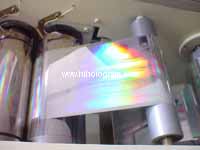
Applications of holograms
From:http://silver.neep.wisc.edu/~lakes/hoAppl.html and en.wikipedia.org/wiki/ Holography and en.wikipedia.org/wiki/ Holography and http://www.optics.arizona.edu/jcwyant/Short_Courses/SPIE-7-30-2000/Session%207.pdf and http://www.holoworld.com/holo/links.html
Holography has today emerged as an important tool in science and technology. It is a well used method to produce pictures and represents one of the most prominent examples of recombining of scattered radiation to produce pictures. This process of producing holograms is now spreading from the research laboratory to various industries, and holograms find wider employment in communication and other engineering problems. A hologram is not only a three-dimensional image but also can store numerous quantities of information. In the computer technology, holograms can be used to store memories which are much larger and faster. Hologram has today become a very well known concept in credit cards, tickets or original covers on software computer programs or any objects to prevent falsification. An important area of application of hologram is bar-code readers in shops, warehouses, libraries etc. A code reader is based on the use of holographic components like optical gratings. Some other examples of the use of holographic technology is in the aircraft industry's head-up displays (HUD) or for making holographic optical elements (HOE) and so on. All these have contributed to make holography an industrial success.
Information from IHMA
Glossary
Get to know a list of certain terms associated with hologram and holographic technique:
Animated holograms: They are made by using time-lapse photography. The object moves between exposures. The object appears to move as the viewpoint changes when the hologram is made from these photos. They are made up of hundreds of image channels
Beamsplitter: This is a device which divides the light from a laser into two separate beams-the reference beam and the object beam.
Channels: They are images in a hologram which change instantly from one to another as the viewer passes by. These images can also fade or overlap as they change.
Coherent light: A coherent light is made from laser and this light is of the same frequency and vibrates in phase.
Computer generated hologram: This is a hologram made from a three-dimensional computer model.
2D/3D Hologram: The hologram is made of multiple 2D layers with hologram images placed one behind another with visual depth that creates an effect of three-dimensional hologram structure.
Diffraction: Bending of light as it passes through very small openings.
Dennis Gabor: He is a physicist from Hungary who discovered the holographic technique and was awarded the nobel prize in 1971.
DOT-MATRIX Hologram: Dot-Matrix Hologram create a beautiful impact of variable images allowing unlimited computer controlled and laser beam engraved dots in hologram.
Embossed holograms: They are made by a manufacturing process which uses a metal replica of a master hologram.
Film: Film consists of light sensitive chemicals or the emulsion spread on a surface.
Flip-Flop Holograms: They can display two images from different viewing angle.
Full color: They represent the natural subject colors as in color photography.
Hologram: A hologram is a record of an image as seen from many viewpoints, giving a three-dimensional effect.
Holography: The process of making hologram is known as holography.
HOE's: These are Holographic Optical Elements, which are actually produced to perform the function of traditional optics, like mirrors and lenses.
Interference pattern: A hologram is formed when two waves overlap. This results in an interference pattern which records the relative phase relationship between the two waves.
Master hologram: The first hologram that is formed and viewable only by laser light, and combined with other masters for the final hologram transfer.
Multiplex holograms: They are stereoscopic holograms made by taking an array of photos with the camera tracking past a subject.
Object beam: The light from a laser beam that illuminated the object and is reflected to the holographic film.
Rainbow holograms: They are transmission holograms where the object appears to change color as the viewpoint moves vertically.
Reference beam: The portion of a laser beam that goes directly to the holographic film.
Reflection hologram: Reflection holograms are viewed with the light source on the same side of the viewer. The light is reflected off the hologram.
Stereogram: This is an alternative to the original hologram process. Here the subject is imaged directly onto the film with a laser exposure.
Tamper evident: Instant recognition of tampering.
Transmission hologram: Transmission holograms are lit from behind or viewed with the light source on the opposite side of the hologram from the viewer. Here the light transmits through the hologram.
Transfer holograms: These holograms are made using a holographic image from a "master" hologram as the object of a second hologram.
True Color Hologram: True Color Hologram is made up of photographic quality art-work, in which counterfeiters can't duplicate hologram close to original one.
Volume Hologram: The angle difference between the object beam and reference beam is equal to or greater than 90 degrees.
White light: White light is incoherent and contains most of the wavelengths in the visible spectrum, like light from the sun or from a spotlight.
A History of Commercial holograms
The following reference gives you an idea about chronological invention of different holograms and their usage in various applications. This reference is provided by IHMA, the International Hologram Manufacturers Associations.
Hologram Badge
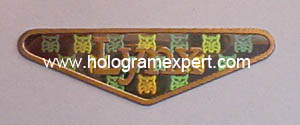
Hologram badges are popular visitor badges, featuring security holograms and are used in various organizations and companies. Most visitor hologram badges have the feature of "time badge" technology which automatically voids the temporary hologram badge after one day. There are other hologram badges, displaying various holographic images. There are some badges used to identify a company's name with the company logo on it. There are some holographic badges affixed on T-shirts, worn not for security purpose but for fashion purpose-preferred by youngsters. The star-trek or super human hologram badges are widely demanded among young children. Hologram badges are also an integral part of school uniform or sports wear depicting your country's name or your school name in a holographic format. Hologram badges are thus highly popular.
Features of hologram badges
Scourec From: www.hologram.name
- Made of paper or plastic or polyester.
- The size is usually of the size of a credit card or slightly larger.
- For security purposes or identity purpose, the badge is usually rectangular in shape. There are other shapes as well. For various star trek hologram badges, they can be of any shapes.
- The security features in hologram badges reduce the risk of unauthorized badge reuse.
- Hologram badges eliminates the need to collect used visitor badges.
- The hologram badge has an adhesive backing which helps it to affix directly to fabric.
- In some badges, there is a clip or a pin to fasten the badge to the fabric, so as to not to destroy the fabric.
- With time technology feature in most hologram badges used for security purposes, the color of the badge changes, thereby implying that the badge is of no use.
- The name on the hologram badge is printed with ink or felt tip pen on the top ply. The names can be thermal printed for high volume applications.
Hologram Card
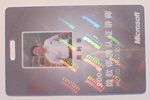
Information Refferece Source From www.securityhologram.com
Hologram cards in the form of hologram ID cards or employee badges and any other cards subject to tampering or forgery are very popular. Any card made of plastic or paper can be made holographic. Holographic overlays are specifically designed to upgrade and improve security and authenticity of your existing plastic or paper ID cards. Hologram image overlays prevent photocopying and forgeries and allows a clear view of ID card information. Hologram cards provide higher visual security and authenticity. Besides security, holographic cards are usually dazzling and eye catching display. There are various designs and colors, shapes- some opaque, some oval or wavy or some in translucent format to give a greater appearance of depth.
Properties of hologram ID cards
- Peel and stick transparent labels are affixed after the ID card is printed.. The size of the hologram overlay is slightly smaller than a standard ID card. Pressure sensitive Self adhesive label.Transparent The hologram overlays are strong.They can be applied to new cards or existing cards.
Hologram overlays on ID cards Information Refferece Source From www.securityhologram.com
- Transparent Hologram ID Card Overlay: This type of hologram ID card applies a transparent hologram film overlay on a digitally printed ID card. This not only protects the inks in the card from excessive abrasion and wear but also the card life and enhance the security of your ID cards. The holographic overlay helps in preventing alterations to the card information and resists copying or duplicating the ID card.

- Custom Holographic Origination Overlay: Another type is an overlay that is as per customer's specification. An hologram overlay with your company name/logo offers the most security for your ID cards.

Types of Master Origination of Hologram Card Lamination Information Refferece Source From www.hlhologram.com
The lamination done on hologram ID cards are as follows:
- DOT-MATRIX Hologram
- 2D/3D Hologram
- Flip-Flop Hologram
- Kinetic movement in hologram
Important factors to consider before making hologram cards
For any photo ID application, the first step is always to get the initial card design right. Once the card layer and usage is determined, the next thing is to consider physical protection and the prevention of counterfeiting. For card security and protection, various questions need to be answered:
- How will the card be carried ?
- How will the card be used ?
- Will the card suffer wear through after it is being physically "swiped" through a reader?
- What level of security protection is required?
Applications of hologram cards Hologram cards are found in the following:
- Hologram ID card
- Hologram credit card
- Hologram Drivers license
- Hologram National ID card
- Hologram Voter Registration card
- Hologram Gun license card
- Hologram Proof-of-Age card
- Hologram Employee ID card etc.
The above cards are all examples of real world ID card applications and they must be completely protected against forgery.
Hologram Copyright Guidelines
In 1994, the International Hologram Manufacturers Association (IHMA) published its Hologram Copyright Guidelines. The basic reason for providing these guidelines is to cover the common situations in the production of commercial hologram where the question of copyright ownership will arise:
- Custom made holograms for a customer to use in relation to the customer's trade or business, such as for promotion or product security.
- Holograms manufactured to be sold, either by the manufacturer, the creator or a separate publisher.
Hologram manufacturers should incorporate the recommendations or guidelines on copyright and the assignment of copyright into their agreements or standard contracts with suppliers and customers.
Refference Information from www.hlhologram.com and www.IHMA.org
Guidelines
The Berne Convention, International copyright and holograms
The Berne Convention is an international agreement subscribed to by over 90 countries. It sets out minimum requirements on copyright law. There is no specific law controlling the copyright of holograms. They are treated as copyrighreference in so far as they are the result of one or more original creative works. There are few jurisdictions to address the identification of a hologram and the copyright on it. For example, the United Kingdom Copyright Designs and Patents Act 1988 is drafted to include holograms in the same category as photographs and/or films. That means, according to Berne convention, a hologram should be copyrighreference in the same manner as a photograph.
Moral rights
Moral rights in copyright works had started in Continental Europe since the 19th Century. Moral rights belong to the individual author or creator of the copyright work and are recognized as totally independent of the copyright itself. Thus, when an employee creates an original work (here a hologram) in the course of his employment, the copyright will belong to the employer, but the moral rights will vest in the individual employee. Four rights have received general acceptance as moral rights . They are as follows:
- The right of paternity: This is the right of an author/manufacturer to attribution of his authorship/manufacturing.
- The right of integrity: The right of an author/manufacturer to prevent modifications to his work/product.
- The disclosure right: The right of an author to withhold his work from publication/to withhold his hologram product from sale.
- The non-attribution right: The right of a person not to have attributed to his authorship a work of which he was not the author or the manufacturer.
Moral rights were incorporated in Berne convention in 1928 which lays out the following features, which can be followed by all countries.
- These rights are independent of economic rights.
- Moral rights continue to exist after the author/creator has transferred his economic rights.
- These rights are to be maintained at least until the expiry of economic rights.
- The manner in which the rights are protected is determined by national law which is not, necessarily, a copyright law.
The IHMA Guidelines/Recommendations
The IHMA recommendations on hologram copyrights are given below:
Custom-made holograms
If a hologram is used by a customer the question of whether the copyright is owned by the hologram manufacture or the customer arises. The same question applies to the artwork and the tools and machines that are used to create the hologram, some of which may be supplied to the hologram manufacturer/originator and some by the customer himself. It is to be noted that a hologram is unusual even if two holograms are made from the same artwork and they could be very different in terms of color, depth, image placement in relation to the image plane and other factors. Thus there will indeed be copyright in the hologram even though it reproduces a customer's trademark.

Information from www.hlhologram.com and www.IHMA.org
There are many components in the image of a hologram custom-designed for commercial use. In such a case, there is every chance of having separate copyright in each of these components, which are :
- The customer's artwork or design, consisting of a registered trademark, logo, product, design or brand name.
- The artwork from which the hologram is mastered, consisting of 2D artwork, video, cine film, slides, a model, a computer sequence or a combination of any or all of these.
- If the hologram is a composite of different pieces of artwork the final composite artwork may exist as a separate entity.
- Copyright on the laser-exposed hologram master or the masters from which the sub-master is exposed in the case of a multiple image or multiple channel hologram.
- The transfer hologram from which production masters or shims are made.
- The re-combined images on a production master or shim.
- The finished or complete hologram.
Arrangements of contractual copyright
When a hologram is made exclusively for a customer there are three alternative recommendations as given by IHMA:
- Assigning copyright: The customer or the client is assigned all rights in the hologram and all artwork stages involved in its creation.
- Retaining copyright: The hologram originator or the manufacturer retains copyright in the hologram and all artwork stages involved in its creation.
- Splitting copyright: The hologram manufacturer retains copyright in the hologram but assigns copyright in the artwork made for the hologram to the customer.
Holograms for publication
If a hologram is manufactured to be published as a hologram for sale, the copyright is given to creator/manufacturer who made the first hologram from which the published edition is produced.
Manufacturer-published holograms
The copyright in a hologram made and published by the same company lies with the creator of the hologram. The creator can be an in-house creator or an independent artist/designer or an outside contractor.
Hologram Glasses
Hologram glasses are actually an improved version of 3D Glasses which have multiple purposes. The glasses as we know help in surrounding every point of bright light with amazing images suspended in the air.
Hologram glasses, just like sunglasses in common parlance, give an immersed three-dimensional visual environment. The experience is quite different & superior when compared to conventional virtual reality glasses. The sickening flicker which one has to face is restricted to the minimum in hologram glasses.
Hologram glasses have lenses are available in variety of special images. The more the simple image, the crisper and brighter are the effects.
Fabrication of Digital Hologram
Holographic glasses have digital computer generated hologram lenses, as found in diffractive optical elements. Hologram glasses generally have the ability to generate diffractive optical elements in the form of binary amplitude and binary phase.
- Binary amplitude in hologram glasses have clear and opaque regions. Thus, these digitally computed regions help diffract the light as per the desired pattern. They have gray tints.
- Binary phase holograms help in creating clear & brighter holographic images. When the blur in the background scene increases, then it leads to increment in image brightness.
How Do Hologram (3D) Glasses Work?
Hologram glasses have 3D features. How does a 3D functions is quite an interesting point which needs proper explanation. The three dimensional effect is produced when a still picture with a red composite image in its right component is superposed on the left component having a contrasting color. The effect takes place when they are viewed through glasses with corresponding colored filters. The brain helps the eyes which are about two inches apart to correlate the picture which are otherwise from slightly different angles. This helps in measuring the distance, known as the binocular vision - View Masters.
Holographic glasses with 3D effect make 3D films worth watching, thus, eliminating blurriness & fuzziness completely. These colored filters help separate the different colored images (as red and cyan, blue or green) being projected from different angles simultaneously. Instantly, the images enter one eye at a time which are later projected as one by the brain.
Advantages of Hologram Glasses
Hologram glasses no doubt have their own set of advantages which is the reason why they are widely used for their multipurpose.
- There is no difference between real & virtual when viewed through holographic 3D glasses. Fantasy world becomes real when seen through a hologram glasses
- The glasses help the eyes to correlate the two different images as one, thus, making it easier to grasp the essence.
- Allows color viewing.
- Technology used in 3D or stereoscopic movies is quite simple.
- Recreates the users with their amazing plus points.
Hologram Mousepad
Hologram mouse pads are a very popular category of mouse pad used for promotional purpose. Mousepads of various types and materials are available in the market today. Lenticular and holographic mouse pads have seen a rising demand today because they serve both the purpose of fashion and functional. They provide that eye-popping promotion that will never be forgotten by any customer. Compared to a normal leather or a rubber mouse pad with graphic, there is no doubt about the fact that a holographic mouse pad will definitely catches everyone's attention. Holographic mouse pads are ideal to make your clients mesmerized as any message or image comes to life through holographic processes increasing the impact of your promotional message.
Materials used
Usually, holographic mouse pads are created using a thick polycarbonate clear plastic top or a polyester surface applied to a dense rubber base. The hologram image is then imprinted on the top. Your image is printed using the holographic process. The image is then layered between a base material and the protective plastic surface creating a mousepad of durability and style.
Properties of holographic mouse pads
Certain unique features of holographic mouse pads are as follows:
- Hologram mouse pads can have 3D effect which means that the image seen will have depth and parallax.
- The mousepads give the illusion of seeing multiple layers of depth.
- Hologram mouse pads can also have flip-flop effect which means that two-three images can appear one at a time.
- There are certain holographic mousepads which shows movement.
- The morphed hologram mouse pads also display changes of images.
- The hologram image glistens through the center of the pad.
- The mousepads can be custom imprinted.
- Incredible print and graphic quality and clarity.
- Available in all sizes and shapes.
Uses of hologram/lenticular mouse pads source from http://www.asia.ru/ProductInfo/764773.html and http://www.bestbuymousepads.com/mousepads/holographic_Mousepads/holographic_mousepads.html and http://www.tradeeasy.com/supplier/86940/products/p902593/3d-lenticular-mouse-pad.html
- Holographic mouse pads make great 3d, lenticular, animation, motion, and morphing mouse pads.
- Holographic mouse pads are a vital promotional product addition to your advertising campaign.
- They are essential gift items to use for employee perks.
- They are used for new customer acquisition.
- Holographic mousepads with company logo and name helps in brand recognition and brand loyalty.
- Hologram mouse pads promote multiple messages in the same space.
- They can grab attention with changing images or motion.
- They help in drawing viewers into your message with realistic 3-D effect.
- Mouse pads are used for various purposes such as follows:
- Photograph frame
- Tea coasters
- Website promotion tools
- Counter mat
- Advertising tools
- Corporate peripheral
- Gift item
- Calendar
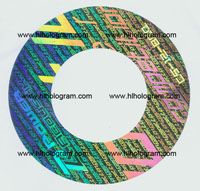 Hologram Poster
Hologram Poster
Hologram posters are not popular as promotional holograms. Hologram poster gives an amazing 3-D experience. These posters can be used for decorative purposes at home, as display boards for advertising and marketing, as banners to give your product or packaging an extra edge over others. Holographic posters can complete the promotional activities associated with your product or just to add some attraction towards it. The holographic posters are also used as movie posters.
Basic feature of hologram poster
The basic feature of a hologram poster is that there is a 3D image which changes its view from different angles. Unlike other 3-D posters, hologram posters provide what is called "parallax". This allows the viewer to move up and down, back and forth, and see different perspectives and make the object look like a real one.
Materials used Paper and Plastic
Process of making hologram posters Hologram posters gives a perspective of 3-dimensional with the illusion of movement. Hologram posters look incredible in almost any kind of light. Holography process allows the recording and playback of true, 3-dimensional images. This process takes images of the same object from different angles and create a image with depth. This image is then printed onto the paper and the image is laminated. There is the look of something real in these posters, creating the illusion of motion.
The next generation movie poster According to a recent published article, a particular company has come up with future of film one sheets or what is referred as "the next-generation movie poster". This poster has embed three dimensional holograms, the movements of which loop over a set period of time. The time is usually in seconds. In other words, this particular poster display an image with movement. The same technology can also be used to present short clips on posters.
Uses and applications of hologram posters
- Hologram posters enhance company's image and some shelf appeal.
- The hologram poster can be customized with any 3D image representing company's logo or name.
- Hologram posters are part of promotion for product.
- They are ideal as as gift items.
- They can be used as decorative poster to enhance the look of your room.
- In large display board or banners, hologram posters highlight or focus something, to attract attention of users or consumers.
- These poster are widely used to display movie posters. Many Hollywood movies like "The Terminator", "The Lord of the Rings" etc. have advertised their movies through hologram posters.
Hologram Pouch Source from Hologram Pouch
Hologram pouches are available in infinite designs with fascinating visual effects. Holographic pouch is a combination of flexible printing technology and hologram technology. The general polyester film is substituted by holographic film. Hologram pouches are laminated covers used in I-cards, license, badges, book marks, hand tags etc. Hologram pouches offer you a high level of protection for ID cards and badges. The card is inserted between the two layers of the pouch, thereby providing durability. These pouches have customized designed holographic images which change color, intensity and perspective with the change in the viewing angle. Holographic pouch are available in a plethora of full color combinations, which makes them attractive.
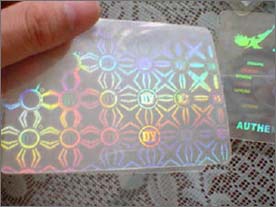 Basic property of hologram pouch
Basic property of hologram pouch
Highest level of optical security features combined with printing technology creates a highly secured pouch, besides enhancing its aesthetic looks.
Process for laminating
- Step 1 : Place the insert in the pouch.
- Step 2 : Place the pouch in a carrier, say a normal business envelope or folded paper. The carrier absorbs excess adhesive which might be squeezed out during laminating. If there is no carrier, excess adhesive will accumulate on the laminator rollers. This will later require dismantling the laminator to clean the rollers.
- Step 3 : Feed the carrier through the laminator. Allow the laminator to get to the normal temperature before laminating. Initially start with a low temperature and gradually increase the temperature until the pouch adhesive is clear after laminating.
Laminating temperature
The laminating temperature depends upon the laminate thickness. A list of ideal temperature range is given below:
Uses of hologram pouches
- Pouches are used to laminate ID cards or licenses or tags which are printed on paper (natural and synthetic).
- The heat-sealed lamination of hologram pouches provides durability.
- Thicker lamination creates a more durable pouch.
- The heat-seal adhesive property of the pouch provides some tamper-evidence.
- Attempts to remove the lamination usually leads to tearing of the paper ID card.
- Hologram pouches offer protection against attempts at alteration and tampering made using common materials and printing processes.
- hese pouches offer your ID cards, badges and driver licenses an effective combination of security and attractive appearance.
- They provide high brightness and perfect transparency.
- Full coverage protects everywhere
Hologram Printer
Infomation reference source from http://holoprinters.com/
Hologram printer when defined is actually a hardware that records the image sequence mechanically onto the master hologram. It holographs the optical image on the LCD which is then 'printed' on the film.
With technological upgradations, supreme quality holographic printers are now available in the markets with high resolution & full color capacity to print a three-dimensional picture.
How does a Hologram Printer works?
Hologram printers make use of holographic technology for creating a lucid three-dimensional images. This is used in hard-copy publications or electronic documents. The very technique of these printers depend on the holographic engineering, i.e. the light order is produced by the meddling of two crossing beams which are :
- The "signal" (or "object") ray. It retrieves recorded material from the optical storage media.
- The "reference" shaft.
Together they form the amazing three-dimensional picture which ultimately is known as a "hologram." The hologram printers are comparatively expensive & complex than the two dimensional color printers. Each object on LCD can be transformed into a hologram & the hologram printer helps in imparting a new look to them. The step motor of the printer helps the film plate move towards the right position which gets fixed later on. Thereon, the particular object from the LCD is exposed on it, & thus, we are able to see the same picture from varied new angles.
Printer Slits
When we talk of holographic printer, then we cannot ignore one of its very pertinent aspect, i.e. the printer's slits. There are slits on both sides of the printer. These are 90 mm high with 0-5 mm in width & having a 1-2 mm opening. The shape has been designed such which completely avoids the projection of shadows on the photographic film plate. The slits are adjusreference on both sides of the printer keeping in mind the varied requirements. As when the reflection hologram lights from the reference gets recorded, then the object beam illuminates the film from opposite sides.
With the help of two micrometer screws firmly placed on printers slit, adjustments are made. Thus, only a bit of the hologram gets exposed. Film plates are installed from the side of the printer. 6 metal springs helps in keeping them firmly placed in a sreference position while 3 springs at the top & 3 springs at the bottom of the film plate holder are placed. All these ensures stability with an easy operation of the printer.
The Micro Controller for the Holographic Printer
Micro controller bridges the gap between the PC and the mechanical printer. It helps control the film plates position & the exposure time by adjusting the shutter speed. In some cases, it is built up of an 8-bits Intel 8031 chip which consists of an Aritmetric Logical Unit, ALU, two 16-bits counters/timers and a 8-bits ports. Unit of the controller has an EPROM which further consists the driving program for the printer.
The Software Program: ARIP Control
In some cases, there is a specific Windows software program known as ARIP Control (Automatic Real Image Printer) which controls the holographic printer. It helps in controlling the generation of images by giving vital signals to the printer controller. ARIP requires bitmap (BMP) format image files, where any kid of picture can be transformed into a hologram. The ARIP control software has got many features which makes it a versatile software. Such as :
- Automatic digital saving of camera clicked photographs & easy transfer to the software.
- Instant scanning & bitmap file conversion of normal camera photographic pictures.
- Easy conversion of video camera films in bitmap format.
- Film can be loaded & at the press of the button film plate is installed in the printer when film holder move to the right position.
- Instant recording starts thereafter.
- The printer is connected to the correct computer port.
- Time is adjusted for the reference to be sreference.
- Adjusting of the shutter speed.
- Button Port used for setting the parameters for the serial port.
- Crystal frequency for controlling the micro controller placed in the printers electronic circuitry.
- Size of the film holder in mm which is set for exposure.
- Step rate between each exposures is duly adjusted.
- Image size is adjusted as well.
Two important holographic printers
- Researchers at Sony Corporation (Tokyo, Japan) have come up with prototype holographic stereogram printers which are based on technology invented at the Massachusetts Institute of Technology Media Laboratory in Cambridge, MA. As published in a news report in 1998, Sony's system, can produce monochromatic holographic portraits of up to 8 X 6 cm in just three minutes and this comprises all the three steps of image acquisition, processing and printing.
- Zebra Imaging Inc. (Austin, TX) have also come up with a device that is also designed to produce an output quickly in less than a minute, without image-processing, for a hologram of up to 13 X 25 cm.

Hologram Seal/Security seal
Hologram seals or security seals are a widely demanded quick and economical way to add security to existing cards and packaged goods. Hologram seals are also used to detect tampering while a shipping carton is in transit or storage. The seals are carefully crafted and produced to prevent counterfeiting. Unlike peel-off seals, the hologram seals leave a dot or checkerboard pattern on the card or packet if they are removed, indicating that the card has been tampered with. Any attempt to remove these seals destroy the seal and nullify the guarantee of authenticity.
The hologram seals are available in various shapes and sizes, including custom made seals with company's logo and images. Additional levels of security can be added with the images that change color and appearance when viewed from different angles.
Features of hologram seal/security seal
- Face Material : Polyester or polymer on paper or acetate. Thickness in various sizes. All colors are available, the popular ones being gold or silver.
- Adhesive : Permanent adhesive of rubber or acrylic composition. The selection is usually dependent upon application.
- Service Temperature : -10 to 90 degree Celsius for polymer based labels and 0° to 70°Celsius for paper based seals.
- Backing : Usually glassine or clear polyester release liner.
- Tamper evidence : High. The image is destroyed when attempted to remove.
- Availability in continuous rolls or individual seals.
- Receptive to writing from ink pen or marker
- No adhesive residue when removed
Types of Hologram seals
There are usually two types of holographic seals available based on the basic substrate used. They are as follows:
- Polyester-based seals : The self-adhesive polyester based hologram seal is ideal for general use. This kind of seal is used where high security is not a main priority. The main uses for polyester based hologram seals include promotional labeling uses and seals for packages, like cosmetics and CDs. The seal is made from a polyester film, easily applicable either by hand or machine. Serial numbering is also available on seals for track and trace purposes.
- Paper based seals : The paper-based seal can be used as an information label, while at the same time providing the authenticity supplied by the holographic strip. The paper hologram seal is ideal for cases where additional labels are needed, like in food and beverage packing where nutritional information and ingredients be provided. The paper seal will work as a two-in-one label. Any attempt to remove the seal will result in the label tearing.
Tamper evident feature of hologram/security seals
Apply hologram sealing tape on the carton seam.
First Tamper evident feature
The word "OPEN/VOID" appears on the carton if the seal is removed.
The “broken seal” feature implies that that the seal is self destructed once it is been attempted to remove.
Applications of hologram seals/security seals Hologram seals are used to sealing cartons and packets for various purposes. Some of the applications are as follows:
Information from www.hlhologram.com and www.IHMA.org and www.security.com
Hologram Tape/Security Tape
Security tapes or hologram tapes or holographic strips are ideal for use on containers, documents, packages, pallets and more because they cannot be removed or re-taped without detection. Hologram tapes are used by many manufacturers and suppliers instead of hologram labels.
In other words, to seal a packet or container and to reduce time consumption for bulk quantity, one can take hologram in tape form instead of label form. Like a normal self adhesive tape, holographic tape can be used for any packaging needs. Holographic tapes are available in general pattern designs as well as custom made designs and are also known as security tapes. The tapes provide tamper-evident protection at the highest level, offering protection for envelope, box and cartons. They offer an effective combination of security and attractive appearance. They have customized designed holographic images which change color, perspective, intensity with the viewing angle.
Types of holographic tapes
According to the demand of the market, there are two major categories of hologram tapes or holographic strips. They are as follows:
- Shrinkage Tear Tape: This is a plastic tape with shrinking property. It is sealed to a packaging material which helps in assisting opening of the pack. This type of tear tape enables packing leveling and ignores wrinkles.
- Laser Tear Tape: The laser tear tapes perform many kinds of anti counterfeit functions. These tapes can be made of single or many kinds of anti counterfeit functions in integrative laser tear tapes.
Properties of hologram tapes
Security tapes or strips are available in the following variants:
- Tamper Evident Holographic Tapes: These tapes offer the best solutions for the exporters who export their products in cartons and who exports highly valuable or confidential products. The tamper-evident hologram tapes will easily disclose whether the cartons or boxes are tampered upon or not.
- Dot Matrix Holographic Tapes: There are hologram tapes with dot matrix feature, which means that there are a number of computer controlled and laser beam engraved dots which create a beautiful impact of variable images on a single tape.
- 2D/3D Hologram Tapes: These hologram tapes are made up of various two dimensional layers. These tapes have very good depth of hologram image.
- Two kind of hidden text/Micro text: The images on the hologram tapes with these features are not seen with the naked eye but with the help of laser reader. hidden text can be used for both anti-counterfeiting and brand protection.
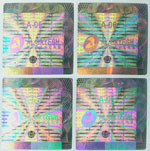
Why is a tamper evident hologram tape preferred?
The tamper evident hologram tapes are specially developed for sealing of cartons, envelope, box, bags etc. When the pattern released tape is opened, it'll leave words like "VOID", "CANCELED", "OPENED", "ORIGINAL" etc. which thereby indicates that the product or the packet has been opened or tampered with. In some cases, the tamper evident feature is a "dots" geometric pattern. The following two photographs of hologram tapes after being tampered with:
How to apply a hologram tape/security tape?
Usually, the security tape is packaged in a roll dispenser box. Cut the tape to length to the specified length using scissors. To apply the hologram tape, remove the liner backing paper at the back to expose the adhesive and apply. If the tape is removed after application, it will leave behind an adhesive residue on the applied surface. This can be removed using a household adhesive remover.
Applications of hologram tape/security tape
Hologram tapes are used for both security packaging and promotional purpose. Holographic tape can be used in the same way as a normal self-adhesive tape. The tapes are widely applicable to the packaging of various products like
They provide the most cost-effective alternative to metals and other film products for a variety of decorative applications, like labels, decals, signs, exhibits, displays, posters, picture frame fashion, and many other unique and creative applications. They are used to seal the cartons. Hologram/security tapes can be used in any type of security application like as
- Government Military
- Industrial
- Commercial
Holographic Aluminum Foils
Holographic Aluminum Foils are in vogue as a packaging material. Aluminium foils are thin sheets (approx. 0.02 mm in thickness) prepared from aluminum. The foil is extremely pliable and since it is thin, it can be easily bent or wrapped around objects with ease. Hence it is recommended to be used as a packing material.
What is holographic aluminum foil?
The holographic aluminum foil is a standard aluminum foil having a three-dimensional effect. The holographic impressions are embossed on the surface of a normal aluminum foil and can be over printed. It is used specially in pharma packaging or tag foil. Holographic Aluminum foils are highly demanded because they provide extra level of security as there are presence of optical security features. Holographic security can be incorporated onto normal aluminum foils that can be seamlessly integrated with any packaging operations. In Holographic aluminum foils, the hologram image can be transferred onto the foil by on-line and off-line method. The on-line transfer of holography can be easily applied on the blister packing machines. The hologram foil can be embossed maximum in width of 160mm.
Features of holographic aluminum foils
- They provide security against counterfeiting.
- They are excellent in keeping out atmospheric moisture and gases.
- The foil acts as a complete blockade to light and odors and bacteria.
- They have optical security features.
Uses of holographic aluminum foils
Standard or customized holographic patterns and images can be applied to films for flexible packaging applications. The foils are easily prinreference by conventional printing techniques and ideal for packing purposes. These foils provide security, authenticity combined with quality packing. The foils can be used as :
- Lidding Foil
- Tagger Foil
- Blister Foil
- As one of the layers in flexible packaging etc.
Applications of holographic aluminum foils
Holographic aluminum foils are used widely in variety of packing applications such as follows:
- Holographic foils are highly recommended for pharma packaging.
- They are used for tag foil. For example: to cover the opening of the containers like milk powder.
- They are used in the protection and packaging of foods, cosmetics and chemical products.
- Holographic aluminum foils are used onto the packing of medicinal pill panal because it improves the appearance of packaging greatly.
- An extremely thin layer of foil is laminated to other materials like plastics and paper, to make durable packs for drinks, dairy products, and other sensitive foods.
Holographic Machinery
No hologram can be created without the help of proper machines. Nowadays, there are wide variety of hologram products available in the market for various purposes. There are security holograms, promotional holograms, hologram for displays, hologram for packaging, decorative holograms and many more. Proper machines are used to make various holograms. Holography Machinery produces hologram film, hot stamping foil to make various products.
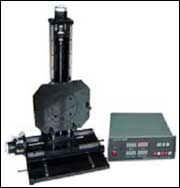
To see more detail please visit source webpage from Hologram Machinery
Description and Specification varies from machine to machine but certain technical specifications that are to be considered are as follows:
List of Holographic Machines
The holographic machinery can be listed below:
2D/3D MASTER SHOOTING SYSTEM
There are two types of 2D/3D master shooting.
- One to shoot master by H1 glass to make hologram text or image in background. To shoot in this type, we have to control position platform manually. This is an easy way.
- Another to shoot master by hologram image maker facility directly. Here, all fore ground image and background image can be shot in same way. There is no need to make H1 glass for background first.
Two different 2D/3D master shooting requires two different position localization equipment-one the manual positioning equipment and the other automatic positioning equipment.
Machines used
This shooting system includes the following machines
- Microprocessor-Controlled Automatic Positioning Equipment: 3D process machine controlling the master shooting according to the presetting parameter.
Specifications to consider
- Voltage
- Power consumption
- Processor
- Shutter
- Value: Horizontal Direction,Vertical Direction, viewing depth
- Times: Horizontal Direction, Vertical Direction, viewing depth
- Scope: Horizontal Direction, Vertical Direction, viewing depth
- Waiting time
- Exposure time
- Speed
- Optical Table:
Specifications to consider
- Load weight
- Solid Frequency Horizontal Direction
- Vertical Direction
- Maximum anti-vibration value
- Table Flat Smoothness
- Maximum relative displacement
- L*W*H
- The weight of whole System
- He-Cd Laser:
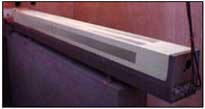
- Opticals
- Silver Coatings
- Other technology transfer
DOT-MATRIX MASTER SHOOTING SYSTEM
There are different resolution like 158 DPI, 317 DPI, 635 DPI, 1270 DPI in this system. It is composed of optical reference, He-Cd laser, accurate platform, programmable controller, optics bridge, computer and software. After you load engraving data, the machine will work automatically until you finish the job.
Specifications to consider
- Platform dimension
- Weight
- Power
HOLOGRAM MASTER RECOMBINATION MACHINE
This machine is used to recombine small master into big master. There are two types of this machine:
1.
Small recombiner recombination: To recombine small master up size to 220mm*160mm. This machine is microprocessor-controlled with automatic simple operation and high precision.
Specifications to consider
- Maximum recombination area
- Recombination precision
- Recombination function: Misplace, blank, reverse, slope
- Control: PC, Windows operation system
- Power
- Dimension
- Weight
2. Big recombiner recombination: To recombine big master up size to1500mm*650mm. This machine is PC controlled with automatic simple operation having high precision.
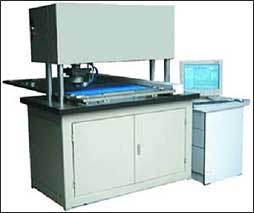 Specifications to consider
Specifications to consider
- Maximum recombination area
- Recombination precision
- Recombination function: Misplace, blank, reverse, slope
- Control: PC, Windows operation system
- Power
- Dimension
- Weight
HOLOGRAM ELECTRONIC FORMING MACHINE
Electronic forming machine is used to duplicate nickel operation shim from hologram mother shim for further processing of hologram embossing. There are two types of this machine:
- Small hologram electronic forming machine
- Big hologram electronic forming machine
Both the types serve the same purpose only the sizes are different. This machine is again of two types: hard electronic forming tank to produce hologram operation shim and soft electronic forming tank to produce hologram master origination.
 Specifications to consider
Specifications to consider
- Max electronic formed size
- Voltage std.
- Power consumption
- Dimension
- Weight
HOLOGRAM EMBOSSER
This machine is used to emboss hologram image onto base material like aluminum metalized PET film, aluminum foil, transparent PET film, etc. This has a very simple manufacturing process.
 Specifications to consider
Specifications to consider
- Max embossing dimension
- Embossed film thickness
- Max rewind & unwind rolls diameter
- Temperature scope
- Embossing speed
- Voltage std.
- Power consumption
- Compressed air needed
- Embosser dimension
- Embosser weight
LAMINATOR
The hologram laminator machine is used hologram material laminating and hot melt adhesive coating machine.
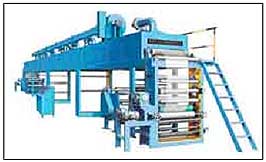 Specifications to consider
Specifications to consider
- Voltage std.
- Power consumption
- Dimension
- Weight
HOT MELT ADHENSIVE COATING MACHINE
The machine is used to coat hot melt glue onto Hologram Hot Stamping Foil.
AUTOMATIC DIE-CUTTING MACHINE
This machine is used to die-cut hologram sticker precisely and fast. It has slitter which can cut big hologram sticker roll into small rolls.
Holographic Packaging Films
Holographic packaging films are used in the packing of various products. These films are ideal for flexible or rigid packaging and hence ideal in packaging industry. It is a known fact that today, the ability of a product to get immediate attention due to the sheer packaging is an invaluable tool to retain and increase market share, in an already over-crowded marketplace. Films are used for printing, gift-wraps, packaging, lamination, stickers etc. The richness of the film is a major factor contributing to the sales of the product that can be achieved by packaging of consumer items. Recently, holography has also developed into a major blockade for duplication and counterfeiting of products such as computer software, credit cards, licenses, pharmaceutical products, etc.
Holographic Film
Information reference source from Hologram Film
What is a holographic film?
Holographic films are very thin, flexible plastic film which are given a holographic effect through various processes like coating, electro forming, embossing, metalizing and many more. The embossing process creates a pattern that has a 3-D effect and spectral coloring. The embossing process refers to cutting tiny grooves into the surface of the film at various angles and in different shapes, which cause the diffraction of regular white light into spectral coloring. Holographic films are used in a wide number of applications.
Process of creating holographic films
Holographic films are created using laser light. This light records a 3D pattern of lines on photographic emulsions. The 3D lines create a diffraction pattern through which light flows at certain angles. The film appears clear except at the diffraction angle. Thus, theoretically the film will direct sunlight to be reflected while preserving the view. The diffraction separates the sunlight's spectrum and creates colored patterns on the material.
Lamination of the holographic film
For various packaging applications, the holographic film can be laminated to different types of materials. The film can be laminated to make the following:
- Sealable films to make form, fill and seal roll stock packaging.
- Sealable films to make pre-made flexible bags.
- Can be laminated to make paper or card stock to make consumer packaging, gift boxes and bags.
- The films can be extrusion coated with sealable polyethylene.
- They can also be coated with special adhesives.
Advantages of holographic film
The advantages of using holographic film for packaging are as follows :
- Customers give higher value addition.
- Inherent security of holography against counterfeit.
- High impact at the point of sale
- Enhanced aesthetics ensure a premium and attractive look
- The holographic packaging films are pressure sensitized which help to make label or sticker or packaging material. This is achieved by applying a pressure sensitive adhesive and a release liner to the metalized surface of the film
- Holographic film can also be chopped into glitter or powder. This can be used on textile products or mixed into other materials to provide a unique holographic effect etc.
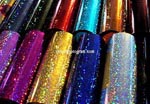 Applications of holographic packaging films
Applications of holographic packaging films
- Pouches
- Lamination with paper
- Board lamination
- Gift wrappers
- Pressure sensitive sticker
- Adhesive tapes
- Carry bags
- Flexible packaging materials
- Decorative packaging materials
- Candy wraps etc.
Types of Holographic films for packaging
Holographic films are available in a wide range, such as follows:
- Holographic BOPP Film
- Holographic PET Film
- Holographic PVC Film
Holographic Packaging Material
Holograms have been widely used in variety of applications like security, promotion, brand protection, anti counterfeiting etc. One important application in recent times is the use of holographic material as a packaging material. A hologram is a three-dimensional image or photograph of an object formed with the help of a laser. To make a hologram, the object is first bathed in the light of a laser beam. A second laser beam is then allowed to fall on the reflected light of the first and the resulting interference pattern is captured on film. When the film is developed, it looks like a wave of light and dark lines which seems to be meaningless. But as soon as the developed film is illuminated by another laser beam, the original object gives a three dimensional effect .
The process of making a hologram is known as holography. In other words, with the help of holography, a three-dimensional visual information is recorded, stored and replayed. Under proper illumination, a hologram displays a multi-dimensional image which can be seen from many angles and depths.
Types of holographic packaging material
Various types of holographic materials used as a packaging material are as follows:
Uses of hologram
Information source from http://www.hlhologram.com/uses_of_hologram.html, www.IHMA,org, www.kuwer.com

Hologram is today used in wide variety of applications. Some of the hologram applications are as follows:
- Security holograms: Holograms are used on a wide range of documents from passports, license, I-cards to banknotes to tickets and passes.
- Access control: Special tamper evident holograms are used to control or prevent access to restricted areas and devices.
- Brand protection: Holographic elements are applied on the labeling or packing which mark the genuineness of the product.
- Advertising techniques: Holograms help to create vivid , eye catching pictures, which adds extra appeal for the customer and in turn generates more interest in advertisement.
Hologram as a packaging material
Holographic materials have been widely used a packaging material. The impact of holography on packaging is great and immediate. It can be so flexible in its use and very remarkable in its effectiveness. Holographic packaging material is the easiest way to get easy attention of your customers and moving your product off the shelf. Holography is used for both both commercial packaging applications and security and authentication. There are different types of holographic materials used as a packaging material like foils, films, label materials etc. Various holographic patterns can be created in varied colors to create package that displays sheer sophistication and dazzling effect. Holographic materials as a packing material have become very popular and economical with the passage of time.
Advantage of holographic material over other packaging materials
information source from: http://simple.wikipedia.org/wiki/Holography
Nowadays , package designers are familiar with holographic treatments like a laminated film or transfer films. Holography is today incorporated into various package designs. Some of the advantages of holographic packaging materials are as follows:
- Holography adorns packages around the world by providing an added dimension of distinctiveness and identity to your brand.
- Holographic images differentiate your package from the competition.
- Holographic materials help to build in levels of security and authentication to protect your brand’s integrity.
- Holography prevents tampering and counterfeiting.
- Holographic film laminates can be sandwiched in between printed film layers and provide dazzling effects.
- Holography provide differentiation and shelf appeal that brings your package to the front on the shelf.

Type of holograms used in packaging
Information reference source from Hologram supplier and www.IHMA.org
- 2D/3D Hologram: This consists of several optical layers with 2D hologram images placed one behind another resulting
- 2D Hologram: This is made up of two dimensional images which are assigned different colors and position in one layer.
- True Color Hologram: This is made up of photographic quality art-work and you can not duplicate this hologram close to original one, creating a beautiful impact of variable images.
- Dot-matrix Hologram: This hologram allows using unlimited computer controlled and laser beam engraved dots in hologram.
- Kinetic Movement Hologram: This is made up of both 2D/3D and dot-matrix type hologram.
- Flip Flop Hologram: They can display two images from different viewing angle.

Applications of holographic packaging materials
Information reference source from www.IHMA.org
The hologram foils or films create various holographic film patterns that create unique, eye-catching packaging designs that also help customers readily identify your products. The holographic materials have now been used successfully in a variety of sectors such as follows:
- Food industry sectors
- Toiletries
- Dental products
- Wine and spirits
- Tobacco
- Detergent sector
- Personal heath care products
- Pharmaceutical products
- Cosmetics Sporting goods etc.
The concept of using hologram as a packaging material is rapidly gaining commercial acceptability on a worldwide scale.
Holographic Paper Bags Information source from http://successprinting.manufacturer.globalsources.com/si/6008818023296/pdtl/Carrier-bag/1000831053/Holographic-Paper-Bags.htm, http://www.asiaexpo.co.in/holographic-paper-bags.htm, http://www.jampaper.com/Bags/HologramPaperBags
Holographic paper bags are widely demanded bags used for various purposes like as shopping bags, gift bags or promotional bags. Hologram paper bags are available in assorted colors, designs and prints and sizes. These bags have three-dimensional effects which make all the difference in marketing and advertising media. Professionally laid out graphic design on these bags can help communicate your message clearly to your customers. That is why hologram bags are used as packaging material for gifts and other stuff in various organizations and commercial outlets. Best and impressive holographic effect can help in corporate branding, sales and marketing advertisements and promotional media. Professionally created 3D design in these paper bags is a key in unveiling the full potential of print media that makes an impact.
Styles of holographic paper bag
Holographic bags are available in various sizes. The holographic paper is available in various colors and prints. Finishing options are applied after completion of holographic process. The designs on the cover are many and varied. Some are custom printed like the name of the company or the company's logo. The holographic effect gives a very shiny and glossy look to the bag. There are hologram bags with embossed effect which gives a raised look. The holographic paper bag can also be foil stamped in Gold, Silver, Copper or any range of colors. The handles of these bags are usually made of plastic or cotton thread.
Uses of holographic paper bags
Holographic paper bags are not supposed to carry very heavy stuff but they are used widely for promotional purpose in big corporates and organizations. They are ideal to be used as gift bags and shopping bags.
Holographic Paper
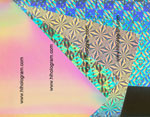
Holographic papers or hologram papers are smooth and shiny papers having 2D/3D holographic effects that reflect and diffract interior and natural lighting. By improving shelf appeal, hologram paper has become very popular to increase sales through improved product awareness and enhanced brand image. The beautiful holographic papers glitter beautifully under the light and add a very attractive effect to all paper craft projects, be it bags, cards, posters or wrapping papers etc.
Process of making holographic papers
The holographic effects are created by metalizing the surface of the paper with a thin layer of shiny silver aluminum. The different holographic patterns are embossed into the surface, which in turn create millions of pixels in microscopic grooves and valleys. In other words, the hologram paper is actually a hologram embossed on the paper which is directly metalized to the paper with no lamination process. This embossed aluminum surface diffracts and also reflects the light. Diffracted light breaks up into various colors and the reflected light sparkles and dazzles to create a more eye-catching appearance.
Advantages of holographic papers
Hologram papers are widely used as a promotional media because of the following reasons:
- The hologram paper increases consumer awareness.
- The hologram paper increases sales because it attracts attention.
- The holographic paper is a multi-dimensional marketing medium.
- These papers create dimension and movement with a variety of colors and patterns.
- Hologram papers are ideal to create exciting projects for both home and office like craft projects, keepsakes, posters, special occasion cards etc.
Features of hologram papers
The various features of holographic papers are as follows:
- Hologram papers are available in sheets and rolls.
- The hologram papers can be given any shape and can be designed in any weight and size.
- Film lamination is used in heavier stocks like board weights.
- Direct embossing is designed for lighter paperweights.
- Transfer lamination process is used to produce hologram paper with the direct embossed qualities.
- Compared to regular paper, hologram paper is more expensive.
- Custom hologram papers are available in super gloss, gloss and dull finishes and appearances.
- They are also available in self adhesive paper.
Information from www.hlhologram.com and www.IHMA.org
Holography Masters
There are generally three types of holograms in the commercial world-embossed holograms, film holograms, photopolymer. Embossed holograms that can be easily mass produced by embossing are the most popular and commonly used hologram products. These holograms are widely used for security, packaging, labels, and display purposes. Holography nickel masters are used to produce embossed holograms.
What is holography master origination?
This is a type of one piece of nickel shim which are manufactured in a laboratory by master shooting system using advanced optics, laser light and photosensitive glass. A holography image created by master shooting system is recorded by a holographer onto photosensitive glass. This glass is then coated with silver layer for electronic forming. This is the manufacturing process of master origination. After electronic forming, we get a piece of holography nickel shim which records holography images and other information in 2D/3D or Dot-master effect. This holography nickel shim is called master origination. We can copy or duplicate lots of nickel shims from this origination by electronic forming.
Steps involved in making holography master origination
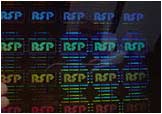 Step 1:
Step 1:
Photosensitive Glass Master Step 2:
Step 2:
Glass master silvered
 Step 3:
Step 3:
Holography Master Origination
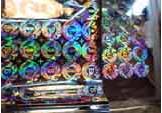 Step 4:
Step 4:
Operation Holography Nickel Shim
Types of holography masters
The different types of Holography Masters are as follows:
- 2D Holography master
- 2D/3D Holography master
- 3D Holography master
- Flip-Flop Holography master
- Dot-Matrix Holography master
- Stereo Holography master
- Photopolymer Holography master
2D Holography master: This type of master origination just has one layer hologram image,. Other than on surface, it doesn't have any other layers. These kind of holograms has several very shining, color hologram image or text on surface, without "virtual depth". The images are more shining especially, in its big rainbow area. The flip-flop effect and most true color image is 2D holography master on surface because it has best shininess.
2D/3D Holography master: 2D/3D Holography masters have been widely used on the commercial securities. In any 2D/3D design, there are typically 2 or 3 layers. There is one layer on the surface as in 2D holography master while the other layers are in the mid-ground and background. There can also be floating layers. The effect gives the appearance of a flat scenery in a theatrical play which is arranged at different lengths from the front of the stage to create the illusion of depth. The depth between the different levels is the most important characteristic of 2D/3D hologram. 2D/3D hologram stickers usually have great visual depths between different layers and shininess on first layer.
3D Holography master: The 3D holography master display a three-dimensional image. This image actually duplicates a solid object derived from a model or a computer generated image. The observed 3D image changes with respect to the direction of view.
Flip-Flop Holography master: Flip-flop holography master produced by 2D/3D master shooting system. This kind of hologram displays two images from different viewing angle. An interesting feature in this hologram is that when the viewing angle changes vertically (upside and down) or horizontally (left to right) different images appear through the hologram. This is also known as two channel effect of 2D/3D.
Dot-Matrix Holography master: Dot matrix hologram creates an array of smaller units or dots. Each dot represents a separate hologram that produces a predetermined result, This result is usually a simple diffraction grating. When viewed at the correct angle and illuminated with a white light source, the diffraction grating produces a tiny spot of color. The microscope gratings are arranged in a proper way to produce a single composite picture. This picture is actually a sequence of related images, for a variety of "special effects". Dot matrix holography master is extremely attractive as they are bright and colorful. This master has lots of kinetic movements.
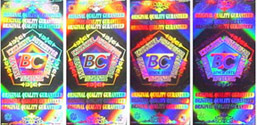
Stereo Holography master: Stereo Holography master creates a 3D effect of an object. It can show a small "movie clip" action sequence. Stereo Holography master or stereograms helps you to see a 3D object hidden inside a picture.
Photopolymer Holography master: Photopolymer holography master forms an image by illuminating the surface of object with radiant light emitted from a laser and then fixing said image. This method for producing holograms by photopolymer technology comprising the steps of: applying onto a surface a composition comprising a photopolymerizable monomer, a binder, and an initiator.
Holography Technology
The holography technology can best be understood under the following two categories:
Recording process of holography
The process of holography uses a reference beam to produce a recording of the phase of the light at every point in an image. The reference beam is combined with the light from the scene or the object which is referred as the object beam. Due to the superposition of the light waves, optical interference between the object beam and the reference beam produces a series of intensity fringes. These fringes can be recorded on standard photographic film and they form a type of diffraction grating on the film. This is called the hologram or the interference pattern.
It is also important to note that during holographic recording, rather than from just one point, each point on the hologram's surface is affected by light waves and these waves are reflected from all points in the scene. It means that during recording, each point on the hologram's surface acts like an eye which records everything it sees in any direction. After the hologram has been recorded, looking at a point in that hologram is similar to looking "through" one of those eyes. For example, you look at a small or cut out section of a recorded hologram. It is evident that from the same distance you see less than what you see in the full image. But still you can see the entire object by shifting your viewpoint laterally or by going very close to the hologram.
Reconstruction process of hologram
Once the film is processed, if there is illumination again with the reference beam, the original object beam in both intensity and phase is reconstructed with the diffraction from the fringe pattern on the film. The image appears three-dimensional because both the phase and intensity are reproduced. The image would rotate exactly as the original object would when the viewer move his or her viewpoint. Since there is an interference between the reference and object beams. There is the use of laser in holography. The light from the laser is divided into two beams-the reference beam and the object beam.
Source:
http://en.wikipedia.org/wiki/Hologram
Difference between recording a hologram and taking a photograph
Recording a hologram is different from taking a photograph in various ways which are given below:
- In hologram, it is necessary that a coherent light source like a laser is used to illuminate the object.
- There is a second beam of coherent light which strike the film on which the hologram is to be recorded. This is called the reference beam. The reference beam and the object beam overlap at the surface of the film and they form an interference pattern.
- The recording material is capable of recording these fine patterns and a high-resolution photographic film is used.
- Because the lines that make up the hologram is usually less than a micron, holographic recording is more sensitive to movement and vibrations compared to photographic recording. This is actually a very serious restriction as it usually confines holography to the laboratory where vibration isolation is created.

Information from www.hlhologram.com and www.IHMA.org and www.security.com
Transparent Holograms
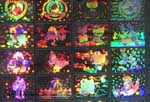
Transparent holograms are the ideal security products where an over laminate is required so that information is viewable through the laminate. In other words, transparent holograms are see through holograms which are affixed over a number, text or a photograph to see through the hologram label the printed information. Any attempt to tamper with the hologram will result in the destruction of the hologram. These holograms are considered to be an ideal solution for document protection where there is the need to secure critical information on the document against any tampering. They can provide your documents/cards with a visually appealing look, coupled with a moderate degree of security.
Basic feature of transparent holograms
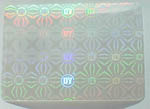
Transparent hologram uses a transparent hologram film overlay on a digitally printed ID card or document or license. This protects the inks on the card from excessive abrasion and wear and also extends the card life. The transparent holographic overlay prevents alterations to the card/document information and prevents copying or duplicating the card. Usually, the transparent holograms are the "peel and label" transparent labels which are manually affixed after the card is printed. They are pressure sensitive, self adhesive holograms. Just remove paper liner to activate adhesive and apply transparent holograms over any important card or document.
Types of transparent holograms
Customized transparent hologram: There are transparent hologram labels or stickers which are custom imprinted with your company logo, name, consecutive serial number and other features. Transparent labels can be customized with a unique imprint.

Tamper evident transparent hologram: The holograms are available with a tamper evident feature. The image is destroyed if any attempt is made to remove the label or sticker from the product or document, or to reposition it. This is an additional security feature in transparent holograms.
Advantages of transparent holograms
The popularity of transparent holograms is due to the following advantages:
- Transparent holograms are compatible with lamination pouches to make ID cards, license, passports etc. They can be affixed to the card insert before laminating. They can also be affixed to the finished laminated ID card.
- These holograms allow easy viewing of the information underneath.
- Transparent hologram is also an affordable method of re-validating an existing card. Since the information can be seen through the transparent hologram, instead of printing new cards every year, it is easy to simply peel and stick the transparent hologram overlay onto an existing card.
- Transparent holograms cannot be scanned or photocopied and hence ideal to combat document counterfeiting.
- Transparent holograms can also create an attractive complement to your existing packaging and product.
- Transparent holograms can also be shining and sharp.
Applications of transparent holograms
Transparent holograms in the form of pressure sensitive labels, pouches and stickers are used in various products.
Types of Hologram
A hologram is a type of three-dimensional image that gives the appearance as a real object as the image has depth. The best way to think of a hologram is to visualize them as impressions on light waves. The patterns of light wave impressions are photographed or captured in the layer of emulsion. In other words, a hologram is an image or photograph of light wave interference. It is to be noted that not all 3D images are holograms and neither a hologram is required to be 3D. In technical terms, a hologram is the captured intensity and phase information which is produced by the interference or interconnection of two or more beams of light. People often consider a hologram as some type of a three-dimensional photograph. However, the only thing common between photography and holography is the use of a photographic film. The important difference is the way the image is produced in both the cases. A photographic image is produced by a camera lens and it is described almost accurately using a simple geometric or ray model for the behavior of light. On the other hand, the holographic image is formed depending on diffraction and interference, which are wave phenomena.
Types of Hologram
Let us now discuss in details the various types of holograms produced under different processes and methods. These holograms are:
- Reflection Hologram: It forms an image by reflected light.
- Transmission Hologram: It forms an image from the light that passes through the holographic emulsion.
- Embossed Holograms: The most commonly used hologram.
- Integral Hologram: A type of hologram formed from series of photographs of an object.
- Rainbow Holograms: A popular type of hologram, viewed in white light.
- Computer Generated Holograms: Computers are used to create images and patterns for developing holograms.
- Multiplex Hologram: It is a type of hologram produced by combining a large number of photographs.
- Stereogram: An optical illusion of depth created from flat, two-dimensional image.
- Volume Holograms: A hologram in which the angle difference between the object beam and reference beam is greater than 90 degrees.
- Plane Holograms: A hologram in which the angle difference between the object beam and reference beam is less than 90 degrees.
Properties of holograms
Holograms have some very interesting properties such as follows:
- Distributed information: The information in a hologram is always distributed. If it is cut into pieces, each piece contains enough information to reconstruct the entire scene.
- Image projection: Under certain cases, merely shining or lighting a laser through the hologram projects an image on to a screen.
- Viewing directly with a point source: A hologram reconstruction shows exactly the same light wavefronts to our eyes that we receive with the real object, using a point source of illumination. The hologram is not distinguished from the physical object.
Hologram: Application
Holography and hologram products are now widely used in various applications. One of the most common application of holography is in security maintenance. Spreading from the research laboratory to industry, holography today finds wider employment in communication and various engineering problems. It is used in computer technology to store numerous quantities of information. Another important application area is bar-code readers in shops, warehouses, libraries etc. Holograms are today considered as the best promotional media. Every type of industry can use the Holographic products to enhance their brands in the market and make them genuine and authenticated brands. Holograms are used for attractive product packaging, security applications, fancy gifts, 3-D art etc. New technology aircraft, automobiles, etc. also make use of holograms.
How is a hologram made?
A laser beam is divided into two beams: The reference beam and the object beam.

Using a lens or curved mirror, the width of the reference beam is increased conically and aimed directly at the film plate. The width of the object beam is also increased and aimed at the object which reflects some of the light on the holographic film-plate. The two beams form an interference pattern on the film by crossing each other. This leads to the forming of the hologram. To create a hologram, laser light is needed because it is made of coherent waves.
Tamper Evident Tape
Tamper evident tape is a simple and cost effective solution for improving the security of various packaged goods as it acts as an effective deterrent against anyone who tries to open the packaging and pretend they haven't done so.
In other words, tamper evident tapes are hologram tapes used for security purposes. These tapes are used on cartons, cardboards, painted surface, metals, glass, plastic boxes and leave a semi-permanent signal on the surface. The tamper evident tapes are used to providing a security seal for letters, cartons, pallets, bags or other containers. These tapes are produced in such a way so that they are compatible with a wide variety of surfaces.
Basic feature of a tamper evident tape
Tamper Evident Tape provides a security seal. The basic feature of such a tape is that after application, when removed the tape will self destruct leaving words or symbols on the package or carton and in the security tape itself. Generally words like "OPEN/VOID/CANCELLED" or dots or checkboard pattens appear once the tape is removed.
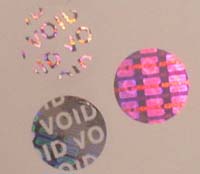 Types of tamper evident tape
Types of tamper evident tape
Today, there are numerous options available when buying tamper evident tape. It is very important to realize that nothing is tamper resistant or tamper proof. If someone wants to tamper with a product they will be able to. The only difference is that with tamper evident tape, you get the indication that that something has been tampered with. This tamper indication is attained with the help of pressure-sensitive adhesives and materials.
The different types of tamper evident tapes that are available are as follows:
- Custom printed carton sealing tape
This is the most common type of tamper evident tape. Generally, the first question that comes up when buying security tapes is "what are you trying to secure, and on what surface?" The common answer for this is usually high valued items packaged in corrugated cartons. Corrugated cartons have a common surface or substrate but there are different types to choose from like smooth, rough, coated or recycled. Some tamper evident tapes work great on some surfaces while poorly on some others. Custom printed carton sealing tape is considered to be the least expensive option. The tape material is usually a PVC or polypropylene and there is an aggressive adhesive suireference for boxes. There are different colors available with imprints and some patterns. If the tamper evident tape is cut and then covered over by clear tape, the imprint will need to line up exactly. Otherwise tampering is indicated.
- Destructible film tape
Another style of tape is the destructible film that flakes when an attempt is made to peel it away. This is used more widely on consumer medicines and food packaging. This is considered very expensive for carton sealing applications. But this is a good option for the smaller jar or bag sealing applications. The security tape is usually imprinted with a diagonal message that says "do not purchase if seal is broken." It also has serrated edges to further prevent peeling away. Relining up the imprint is very difficult once the tape is cut. Hence, this indicates that the tape has been tampered with.
- VOID or Evidence Tape
This is the most popular and the most expensive security tape options. When the tape is peeled away, there is a message imprint left behind on the adhesive residue. The message displays a VOID or OPENED message. The tape is used to seal almost anything.
How secure is the tamper evident tape?
The tape for sealing a carton or any packaged item is either cut or peeled away, though the cut option is more common. If a person plans on tampering with a carton, he will more likely cut the tape, then seal it over with another tape or a clear tape. This is where the imprint is important. When a small pattern of the tape is cut, it needs to be lined up if the box is resealed and this is difficult. That is why tamper evident tapes are secured because they easily give an indication that they are tampered with.

Uses of Tamper evident tapes
Tamper evident tapes are ideal for use on cardboard and other forms of outer packaging. This is because they leave a semi-permanent signal on the surface to which they are applied. Typical users include
- Computer hardware
- Computer software
- Mobile phone
- Medicines
- Food packaging
- Shipping cartons
- Electrical goods packaging etc.
Using this tape, sellers or manufacturers would benefit from knowing whether packaging has been tampered with.
Tamper Evident Seal
Tamper evident seals are widely used by those organizations looking to overcome tamper evident, security and brand protection problems. These seals are used to detect tampering with objects containing confidential information, calibration/equipment settings or valuables. If removed after application, the tamper evident seal will self-destruct in a manner to denote that the seal has been broken. The seals are designed to show signs of tamper evidence immediately if removed. These seals are available in standard and holographic versions. Tamper-evident seals are widely used in government, industry, and in the consumer world to detect any kind of unauthorized attempts to open a secured item.
Types of tamper evident seal
Tamper Evident Feature
Acetate tamper evident seals: The seals are constructed of thick acetate, which will tear if the seal is removed. They are recommended for indoor use and short term use outdoors.
Frangible acetate tears when removed. There is no residue.
Plain Silver tamper evident seals:
This is constructed of thick polyester film with a permanent acrylic adhesive. This type of seal is compatible with most surfaces like paper, glass, metal, and many other surfaces which are hard and non-porous.
DOTS pattern. Once the seal is removed, they leave behind dots on the surface.
Translucent tamper evident seals: This seal is translucent in the sense that you can still read underlying information after application. The seal is constructed of thick polyester film with a permanent acrylic adhesive which is compatible with most surfaces. It leaves the word "OPENED" in a high residue on the surface, once its been removed.
Selective release (OPENED/VOID.CANCELLED), high residue
Forms of tamper evident seal
Tamper evident seals are available in various forms such as follows:
- Frangible foils or films
- Plastic wraps
- Pressure-sensitive adhesive tapes
- Crimped cables etc.

It is to be noted that tamper evident seals are simple seals designed not to provide additional security, but only to provide evidence of tampering, if it occurs.
Options available in tamper evident seals
- Optional logo or graphic
- Optional serial numbers
- Optional colored imprint (red, green, blue or any other color)
Tamper Evident Holograms
Tamper evident holograms in the form of stickers, seals, labels are widely used holograms in various applications. Tamper evident is a process that makes illegal access to any protected object easily detected.
Tamper evident holograms are available in both reels and sheets to suit any kind of needs-manual or mechanical. They are usually pressure sensitive and are are available in colored, transparent or translucent films.
Properties of Tamper evident holograms
The unique feature of this type of hologram is that once affixed at the required place, any attempt to reuse these holograms will lead to their destruction. This is because of the following reasons:
- Some tamper evident holograms are very brittle and will self-destruct when tampered with. This prevents swapping of stickers or labels
- Some tamper evident holograms will leave behind a residue or sticky substance when they are peeled away. Common messages like "VOID", "OPENED" and checkerboard patterns appear at the desired place.
- There are some tamper evident holograms that changes color if they are peeled away.
Tamper evident hologram products
Tamper evident labels and seals examples include some of the following:
- Asset labels and tags
- Computer security label seals
- Product warranty VOID tamper evident labels
- Bag seals
- Drug transport security seals
- Carton sealing printed security tape
- Chemical drum security seals
- Bag sealing tamper evidence tape
- Container security seals and tape
- Hologram Labels with Custom Imprint
- Hologram Labels without Custom Imprint
- Passports
- Identity Documents
- Bank Cheques, Drafts
- Driving License etc.
Types of Tamper evident holograms
Tamper evident holograms are of the following types:
- Full transfer tamper evident hologram:
In this type of hologram, the labels or seals once fixed at the desired place, it is not possible to remove them. Any attempt to remove the hologram or tamper with it results in only the top layer of the film to be separated from the holographic image. What is left is just a clear film, while the holographic image stays where the hologram was originally affixed. This type of hologram is available in various colors.
- Partial Transfer tamper evident hologram:
In such type of hologram, any attempt to tamper with it or remove it results in the holographic image breaking up. Partly the film is removed or partly the substrate on which the hologram was affixed breaks up. Any further attempts to still remove the hologram image intact will result in completely destroying the hologram. Partial transfer tamper evident holograms generally carry a checkerboard or circular pattern.
- Transparent holograms:
Transparent holograms as the name suggests are see through holograms. They can be fixed over a number, text or a photograph to make sure that they can be clearly visible. Any attempt to tamper with the hologram will result in the complete or partial destruction of the hologram.
- Translucent holograms:
They are also see through holograms. While transparent holograms merge with the substrate on which they are fixed , translucent holograms stand out and are easily noticeable. They can be partial transfer or full transfer.

security hologram
Security holograms are the most common type of holograms used in many industries. Security hologram products like stickers, labels, cards are found on a host of products and packaging, which include compact discs, cosmetics, computer software, watches, sporting goods, hang tags, certificates, tickets , passes and many kinds of identification and membership cards. The most common example of a security hologram is one on every VISA® and MASTER CARD® produced for the past 12-15 years. In various countries like Austria, Bulgaria, Finland, Kuwait, Switzerland, and Russia, security hologram is seen on federal currency and passports. In the United States, it is common to find high security holograms on driver's licenses as well as on postage stamps and on a variety of government issued bonds and certificates.
Types of security hologram products
The various types of security holograms are as follows:
Tamper Evident Holograms
Hologram Labels
Hologram stickers
Hologram Hot stamping Foil
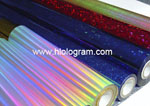
Hologram Tape/Security Tape

Hologram Seal/Security seal

Hologram Badge
Tamper Evident Seal

Transparent Holograms
Hologram Tag
Why security holograms work?
Security holograms are rapidly becoming an essential method of protection against counterfeiting. All holograms belong to a class of images known as Diffractive Optical Variable Image Device (DOVID) which is expensive, a specialized and technologically advanced equipment. Security holograms or for that matter any other hologram products cannot be copied by standard printing techniques or replicated by color copiers or computer scanning equipment. Usually, counterfeiters select the path of least resistance, and as such facing a security hologram will frequently cause them to give up their efforts to copy your product and move on to easier targets. As a result, the use of security holograms virtually guarantees product authenticity.
Advantages of security holograms
The basic advantages of security holograms are as follows:
- They provide security.
- They provide authentication.
- They provide protection against counterfeit.
- They cannot be copied.
Choosing the Right Level of Protection
The importance of adding security hologram to a document or product depends upon the magnitude of the potential loss. Adding a security hologram to your product does not mean that you are preventing counterfeiting, but it significantly becomes a block for the counterfeiter. The security a hologram provides depends to the extent tied to the complexity of the image. This is because all products do not need the same protection. Different security holograms have varying security levels. The required level is ascertained by examining several factors such as follows:
- Actual or perceived product value.
- Cost involved in money or breach of security if your product is bootlegged.
- The possibility that a counterfeiter will go to extreme lengths to copy both the product and its DOVID authentication.
Uses of security holograms
Security holograms are used to serve the following purposes:
- Document Protection
By using tamper evident security holograms, you can prevent scanning, photocopying of your valued document/certificate. It can be applied over signature on valuable documents and certificates. An additional benefit to the hologram is the use of sequential numbers. Self destructing holograms can also prevent removal and reapplication to another document.


- Product authentication
Security holograms are used in different industries like pharmaceuticals, auto & airline parts, software and most other consumer goods. You can add to your product added security, visibility and the ability to differentiate your goods from potential counterfeiters, by using security holograms. It may prevent potential liability issues as well.
- Identification Verification
A security hologram applied on your identification badges enhances security and visibility. You can prevent unauthorized personnel from gaining access to sensitive materials.
Applications of security holograms
Security holograms are used in the following:
- Apparel
- Cigarettes
- Media - Software, DVD's & CD's
- Consumer Electronics
- Handbag/Wallets/Backpacks
- Watches/Parts
- Footwear
- Sunglasses/Parts
- Toys/Electronics
- Headwear
- Tax Stamps
- Pharmaceuticals
- Gift Certificates
- Auto/Airplane Parts u Identification cards and papers u Phone Cards
- Lottery Cards
- Admission Tickets
- Banking Documents
- Transportation Passes etc.
Reflection Hologram
There are various types of holograms. The most common ones are the reflection hologram and the transmission hologram. Reflection holograms are those holograms which are viewed with the light source on the same side as the viewer. This is a reflected light as the light is reflected off the hologram. This hologram is the most common type shown in galleries. In such a hologram, a truly three-dimensional image is seen near its surface. The reflection hologram is illuminated by a ray of white incandescent light. The light is held at a specific angle, distance and located on the viewer's side of the hologram. The image thus formed consists of light reflected by the hologram. Nowadays, these holograms are also displayed in various colors and their images are indistinguishable from the original objects. For example, the holographic image of the mirror reflects white light, the holographic image of the diamond is seen to dazzle or sparkle etc.
Why are reflection holograms important?
The various reasons for making and using a reflection hologram are as follows:
- Compared to the transmission hologram, the exposure time is generally shorter which leads to a less stringent condition on the mechanical stability required.
- The reflection hologram can be easily be viewed with a point source of white light or the sun, which is not the case with other holograms.
- The reflection holograms are used widely because they are viewed with reflected light.
Properties of reflection hologram
Some common properties of reflection hologram are as follows:
- These holograms can be viewed in regular light.
- The finished reflection hologram is monochromatic , i. e., there is a single color for each laser color used.
- Colors of reflection hologram can be shifted by pre- or post-shrink/expanding recording material.
Recording process of reflection hologram source from http://www.fou.uib.no/fd/1996/h/404001/kap02.htm and IHMA
1-step reflection hologram:
In comparison to a transmission hologram, the recording of a reflection hologram requires 10 to 100 times more power. This leads to a longer exposure time. During the process of recording the hologram, the two beams-the reference beam and the object beam-lights the film plate on opposite sides which results in high resolution of film emulsion. The two beams of coherent light traveling in two directions interact. The fringes are formed in layers and are more or less parallel to the emulsion's surface. The reflection hologram selects the appropriate band of wavelengths to reconstruct the image if it is illuminated by a highly directed beam of white light like a spotlight or sun light. This is because a reflection hologram reflects light within a narrow band of wavelength and the remainder of the light passes straight through. The entire process is illustrated in the figure below.
2-step reflection hologram:
The 1-step reflection hologram is not always practical. Another method that is used is called 2-step reflection hologram. In such a method, first we make a transmission hologram called H1. This is the master hologram or the first hologram. We make multiple copies from the master hologram. Transfer copies are made in quantity from the master. Transfer copy means making another hologram using the image on the master as the subject. These transfer holograms are either laser-visible transmission holograms or reflection holograms H2. Suppose we want any object in the final hologram just to appear half in front and half behind the recording plate. In such circumstances, the 2-step hologram is of great use. Now, since we can make a hologram or a copy of the H1's image, we can move the image around to wherever we want it positioned. In other words, we adjust the H2 recording plate so that the image of the object is half in front and half behind the plate and then make our H2.
3.
Sources of illumination of reflection holograms
The different holograms are differentiated by the way in which they are lighted or illuminated. In case of reflection holograms, there are different film emulsions which make images with different characteristics. These are as follows:
- Silver Halide: Silver halide glass plates are used to achieve the highest quality images. This is the most common emulsion of choice for most artists and holographers. Silver halide film, usually cheap, less fragile and easy to handle. The drawback is that it does not produce the depth, resolution and projection which are possible with glass plates. However, such kind of film is used successfully for longer production runs.
- Dichromated Gelatin (DCG): This is a type of chemical-gelatin mix. The mixture is coated onto a piece of glass. It produces very bright images in a golden-yellow color. The images formed using DCG have the least range of depth, but they are easily viewable in normal room light without using any special spotlights. This makes DCG a suireference option for small gift products used in both consumer gift market or the premium & incentive industry.
- Photo polymer: This is one of the newest of the recording materials. Photo polymers are suireference for long production runs and have a plastic backing. Compared to silver halide, the image depth of photo polymers is slightly less. The images are brighter, with a wider angle view.
Rainbow Holograms Source from en.wikipedia.org/wiki/
Rainbow _
hologram and IHMA.org
Rainbow holograms are a very popular type of holograms which can be viewed in white light. The rainbow holograms are very practical holograms displaying three-dimensional images because the images are reconstructed by white light. It is also known as Benton hologram, named after its inventor, Dr. Stephen A. Benton of MIT. The Benton hologram or the rainbow hologram is a transfer transmission holograms. It is essentially a hologram of a hologram. Here the first-generation hologram , that is the "master" hologram is masked with a narrow slit. The rainbow hologram distributes wavelengths of white light in different directions. This leads the viewer to see the image by light of only one wavelength and the actual wavelength is determined by the viewpoint. Depending on the viewing angle, the color of the hologram changes and hence the term "rainbow". A popular example of the use of rainbow hologram is in visa cards.
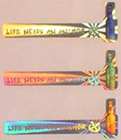 Property of rainbow hologram
Property of rainbow hologram
An important property of rainbow hologram is that perspective information is lost in one axis. That means you may not be able to see a change in perspective when looking from above or below.
Recording process of rainbow holograms
Rainbow holograms are made by a double holographic process. Here an ordinary hologram or a transmission hologram is used as the object. The second hologram is made through a slit. This is a horizontal slit which limits the vertical perspective of the first image and there is no vertical parallax in the resultant rainbow hologram. During image reconstruction, the horizontal slit operates. It removes or eliminates the coherence requirement on the viewing light. This makes it easy to attain the three-dimensional character of an image while the viewer moves horizontally. The brightness of the image is also maintained. If the viewers eye is moved vertically, no parallax is seen and the image color moves through the rainbow spectrum from blue to red. It is seen that when a rainbow hologram is viewed at an average height, the image appears yellow-green. On a little higher height , the color changes from orange or red and if we dip, it becomes blue or violet. Thus, it is referred as rainbow.
Technological steps of producing embossed rainbow hologram
The procedure of producing embossed hologram in mass production is explained below in the following steps:
- First step: Origination. The result is a three-dimensional model or several slides for 2D/3D holograms
- Second step: Recording a normal transmission hologram. In this step, respective image is seen in coherent laser light.
- Third step: Recording phase-relief master hologram viewable by sunlight. This is done by using reconstructed image of the transmission hologram as a subject.
- Final step: Producing metallic copies of rainbow hologram by electroplating. Mass production of rainbow hologram copies by embossing as a final or last stage.
Advantages of rainbow hologram

Rainbow holograms are popular commercial items because of the following reasons:
- Easy viewing
- High brightness
- Vivid dimensionality
- Ease of replication
Applications of rainbow hologram
Rainbow hologram is widely used in a variety of applications such as follows:
- Decorative and product packaging
- Promotional labels
- Protection of financial and other documents
- Protection of branded goods
- Gift wraps
- Greetings cards
- Used in advertising, magazines and other high volume projects
- stickers
- Displays
- Image processing etc.
Promotional Hologram source from http://www.wonderpacindia.com/security-hologram.html and http://news.homai.org/category/promotional-holography/
Holograms are used for variety of purposes like security, anti counterfeiting, promotion etc. Holography is a process by which three-dimensional images are reproduced and stored using laser light or electronic beam. The hologram or the image thus formed is nothing but an exposed, developed, fine-grained piece of photographic film having depth. The difference between a hologram and a photograph is that unlike a photograph which records an image as viewed from one particular viewpoint, a hologram is a record of an image or an object as viewed from different viewpoints. Invented in 1947 by Dennis Gabor, the word hologram was formed from the Greek words, holos, meaning "whole" and gramma meaning "message". Indeed a hologram thus record the the "whole message" of an object. True to their name, holograms today are used to carry a various messages in a vast array of shapes, sizes & forms across a wide range of objects & products.
Promotional hologram products
There are various promotional hologram products
Benefits of hologram
Holograms add value to the product not only by branding but also by restricting adulteration and duplication. Being three dimensional, they have depth, movement /parallax and different colors seem to pass through them when viewed from different angles. The three main benefits of holograms are as follows:
- Security: Since holograms are impossible to duplicate, they have become an essential part of the security programs of many governments, organizations and commercial establishments in their quest for full-proof safeguards against counterfeiters. Holograms are unique and extremely effective as security devices. They are applied to a variety of media in various forms which allow their marking & identification.
- Anti-Counterfeiting: There is no doubt about the fact that the volume of fake or counterfeit goods on the market are ever increasing worldwide . Holograms cannot be scanned/photocopied/duplicated and hence are used extensively as anti-counterfeit devices on various products like documents, certificates, credit cards, license, tags, passports and even currencies.
- Commercial: Since holograms represent attractive graphic mediums and are difficult to replicate, they provide rather convincing proof of the authenticity of products. Holograms, sold in the market in a variety of forms, provide an effective way of communicating & protecting brand identity.
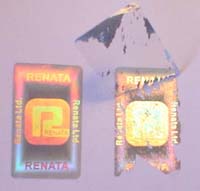
A basic idea about promotional hologram
Since holograms depict images with an added dimension of depth, they are used not only for security purposes but also for promotional purposes. Promotional holograms/3D Lenticular are widely used to give your company logo, product or special promotion a distinctive and an unique look, which will enhance your image and create eye-catching self appeal. Hologram products are used as promotional products since a long period of time. Various products make excellent corporate promotional products through holography imprinting and other customizations. The manufacturing processes used in the making of Promotional holograms/3D Lenticular are not as complex, secure or proprietary as those used in making security holograms.
Process of making promotional hologram products
Promotional holographic products are usually made from laser express holography Laser express holography has two main technologies:
- Photo polymer technology
- Embossed technology
Both technologies have their own merits and demerits, and there are situations when one technology is more favorable than the other. However both the technologies offer exciting and high-impact holographic imagery, which enhance your promotional product.
Types of promotional hologram
- 3D holograms: 3D holograms are manufactured by interlacing the layered graphics of one complete master image. The observed image is a three dimensional image which changes corresponding to the direction of view.
- 2-channel flip holograms: The 2-channel holograms are formed by interlacing the graphics from two separate images. Both the images are available in one layer. In its final form, the first image appears and when there is a slight change in the viewing angle, the second image appears instead.
- Animation hologram: An animated hologram is formed by interlacing the graphics from more than two separate images. The process is somewhat similar to the two-channel process. The only difference is that changing the viewing angle causes the images to appear in a sequential order thereby simulating the animation.
- Flip flop hologram: In flip flop hologram promotional products, the image changes from one to another, as the viewing angle changes.
Articles
Display holograms are widely used as a powerful tool wherever an audience needs to be reached. They are popular and used frequently for eye-catching displays at trade fairs or presentations-a truly unique and amazing way to present objects, corporate images, educational materials and many more. This type of hologram is recorded on to a photographic glass or film plate. The photograph of a virtual object reproduces real 3D magic in display hologram. Display holography is basically a large-scale holography which can play a vital role to get the impact and attention you have been seeking.
Information reference source from Hologram and www.IHMA.org and http://en.wikipedia.org/wiki/Holography
Article 1: A basic idea about Holographic Windows
With the advancement of holographic technique, it has now become possible to control the reconstruction of a hologram's object wave in a common desktop-window environments. The holographic emulsion is transparent if it is not illuminated when mounted in front of a screen. In this case, an interaction with software applications on the desktop is possible in a familiar way and the entire screen content is visible.
The holographic content whether visible or not is always located at a fixed spatial position within the desktop. An application that renders the graphical content can run in a 'Windows' mode, thereby covering an arbitrary area on the desktop behind the emulsion. If the position and the dimensions of the graphics window are known, the projector-based illumination binds the reference wave to the emulsion portion that is located directly on top of the underlying window. Thereby, all the techniques are limited to the window's boundaries. The remaining portion of the desktop is not affected by the illumination-the holographic content or graphical content. The graphical content can also remain registered with the holographic content. This effective technique leads to a seamless integration of holograms into common desktop environments. We can temporarily minimize the "holographic window" or align over the main focus while working other applications.
The figure shows a holographic window on a desktop together with other applications. It shows an optical white-light reflection hologram of a dinosaur skull with combined graphical 3D soft tissues.
Article 2: Household items in holography
Information reference source from Hologram and www.IHMA.org and http://en.wikipedia.org/wiki/Holography
According to a recent research, there are certain items of regular household use which can be used in holography, thereby saving you from lab expenses. The following examples will be of great help to you to make holograms at home but of course with proper care and safety measures.
- For blocking stray light, you can use black foam board.
- A thick piece of glass can be used as a beam splitter. Place a small piece of electric tape over the glass to block the secondary reflection off the back.
- Using old 8 mm movie cameras, you can make a shutter. They consist of a low voltage electric shutter. You can remove this and set up a circuit with a switch and the original voltage of the camera.
- The dampening mechanism between a holographic reference and the support legs can be attained by using rubber inner tubes.
- A slab of granite can be used as a holographic reference.
- Most fax machines or photocopiers contain front surface mirrors.
- To dry a piece of holographic film or plate after processing, you can use a hair dryer.
- You can use a microwave to heat the deionized or distilled water needed for mixing up processing chemistry.
- Two pieces of window glass pane and binder clips can be used to combine a piece of holographic film. This will enable to hold the film rigid and flat.
- Clothes pegs can be used to hang up films to dry. Using the pegs, clamp the film at two corners on the line, clamp two more at the bottom corners to keep the film straight while drying.
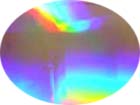
Article 3: Use holography in packaging to increase sales
Information reference source from Hologram and www.IHMA.org and http://en.wikipedia.org/wiki/Holography
There is no doubt about the fact that packaging has a direct impact on sales-an attractive packaging can surely influence consumer's perception of the product and build brand recognition. There is again no doubt about the fact that incorporating holography onto package design is a wonderful way to make your package look attractive and authentic, thereby increasing sales. The question is whether incorporating holograms on package is expensive or not. To be frank, holography increases the overall cost of producing a package but this cost is offset by the additional sales of that product. The use of holograms in the package make your product look more interesting to the customer with its added dimension of distinctiveness, its value increases and above all, it becomes a secured product, which in turn leads to brand promotion. The use of holograms on any package serves a multipurpose task of brand promotion, brand protection, security and of course increased sales.
For example: You visit a local store to buy a toothpaste and as you move to the toothpaste aisle, you go for those packages which come to life, and avoid those which fade into the background. SmithKline Beecham, Aquafresh, Colgate Palmolive are just a few of the companies who recognize the importance that holography plays in package design and perception.
Companies have today come to the conclusion that holographic packaging indeed heightens the success of new product launches, helps to differentiate their products at the point of purchase, allows brand owners to gain market share, retain their leading market position by establishing a stronger brand identity.
Holography provides the visual impact on a package that leads to increased sales and profit, and also justify the moderate increase in costs. Holography is indeed a cost-effective way to increasing sales.
Article 4: How to apply Tamper Evident Labels?
Information reference source from Hologram and www.IHMA.org and http://en.wikipedia.org/wiki/Holography
The tamper evident hologram labels usually have a "dots" release pattern or words VOID, OPENED, etc. showing tampering. Under normal circumstances, the release pattern will appear when the label is removed after the label has been applied. However, there are certain conditions under which the tamper evident feature can be inadvertently activated during the process of affixing the label. We give below few tips to minimize pre-triggering of the tamper evident feature in labels:
Tip 1. Minimize pressure and contact with the adhesive side of the label. Manually remove the label using light pressure and transfer to your finger. Then, apply the label immediately to the intended surface. The tamper evident feature gets activated the label is positioned on your fingers for long time or if the adhesive side is handled with too much pressure.
Tip 2. When handling the labels, use skin moisturizer to the tips of fingers which will touch the adhesive side of the label. This will minimize the chance of activating the tamper evident feature during application. Otherwise use a rubber finger tip on the finger which is to touch the adhesive label.
Tip 3: Flag the label. In other words, peel back a portion of the liner to expose a small portion of the adhesive side of the label. You now affix the exposed portion of the adhesive to the intended surface. Next peel away the balance of the liner to fully affix the label.
Tip 4: Never use a metal or plastic instrument to affix the label. The hard and dry surface cause the tamper evident release to activate.
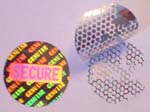 Promotional holograms/3D Lenticular are used for
Promotional holograms/3D Lenticular are used for
- For advertising and sales.
- For brand promotion
- As give-away in trade fairs.
- Used on magazine, books, brochure cover, greeting cards etc.
- Used as mementos, keepsakes or tokens.
- Several 3-dimensional multicolored images of deities, places of worship, monuments, palaces, structures, buildings of historical or archaeological importance.
- Full-color holograms can be considered as exquisite exhibition pieces and presentation plaques.
Multiplex Hologram
Multiplex holograms are used very widely today in various applications. The multiplex hologram is a popular type of hologram depicting the holographic storage of photographic information. It is a type of hologram which is produced by combining a large number of photographs in a holographic manner.
We all know that a hologram usually provides a way to record and reproduce a three-dimensional, still image of an object. The method of recording and replaying a three-dimensional, moving picture is called a multiplex hologram. In multiplex hologram, a three-dimensional image is viewed in a slowly turning transparent cylinder. In other words, multiplex holograms represent large number of flat pictures of an object which is viewed from different angles. These pictures are then combined into a single, 3D image of the subject. In case of a rainbow hologram, the same image of the object appears in a different color when viewed from different angles.
Property of multiplex hologram
Multiplex holograms are an interesting type of hologram. Some important properties of these holograms are as follows:
- Multiplex holograms not only represent a three-dimensional image but also have the possibility of capturing movements.
- Usually a multiplex hologram creates horizontal parallax and not vertical parallax. This is because the camera usually moves around and does not usually pass over the subject. The subject moves around in front of the camera.
Stages of production of multiplex hologram
Information reference source from http://www.holo.com/holo//book/book5.html
- First stage: A group of photographs of the object is taken. The number of photographs taken depends on how much of an angle of view you want to view of the object in your finished hologram. For example if 360 degree view of the subject is required, then you can expose 3 frames or stills per degree of movement around the subject. This will result in the exposure of 1080 frames.
- Second stage: When your film is developed, the next step is to make a series of "slit" holograms. Here you use each frame of film as a subject for each slit of holographic film. This is done in the holographic lab, using a laser. The slits are usually about one millimeter wide. These narrow strips capture the movement process only two-dimensionally, and then they are subsequently recorded on the hologram plate. They are packed together so close to each other that there is no "dead space" in between.
- Third stage: Also the hologram is bleached so that the strips disappear. The result is a hologram comprising more than 1000 different strip holograms.
Manufacturing Process of a Hologram
Information reference source from http://www.IHMA.org
A hologram is made by illuminating a 3-dimensional (3D) object in the powerful beam of laser light. Light waves that are reflected from the object makes a pattern. This pattern is recorded on a special type of holographic plate. When this is developed and light falls onto it, the original object is recreated. This image appears as a fully three-dimensional image. A large number of new creative possibilities is opened by holography using a new visual reality. Holography allows any artist to produce his type of work which on the other hand would be impossible in any other medium. There are nowadays advanced laser techniques with various art forms producing an entirely new level of artistic expression thereby creating an enchanting environment for home or office. Holograms are usually light and easy to send or carry and make a a wonderful gift or a fascinating addition to any collection.
Steps in making a hologram
Steps involved in producing a holographic image of an actual, three-dimensional object are as follows:
- Mastering
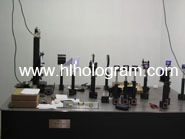
Step 1: A laser is used. This laser illuminates the physical object. The reflected light falls on the photoresist plate. At the same time, a reference beam from the laser falls directly on the photoresist plate. There is an interference between these two light beams which react with the photo-sensitive coating thereby recording a holographic image of the object.
Step 2: The master is the plate on which the original hologram is recorded. The master is processed in a chemical bath using standard photographic developers after being exposed. The master is also expected to confirm that the image is properly recorded before proceeding with production.
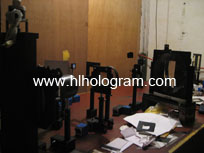
- Electroforming
Step 3: The master is mounted into frame. It is then sprayed with silver paint which helps in achieving good electrical conductivity. The frame is put inside a tank along with a supply of nickel. An electric current is produced, and the master is electroplated with nickel. The frame or jig is then removed from the tank and then it is washed with deionized water. The metal master shim, which is the thin, nickel coating, is removed off the master plate. This shim contains a negative image of the master hologram. The negative is the mirror image of the original hologram.
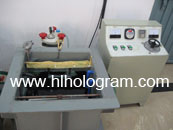
Using the same processes, several shims are created. Those that are produced from the metal master shim are known as "grandmothers,". "Grandmother shim" contains positive images of the original hologram. At this times, various copies of the original image are duplicated in rows on one shim and are used to print multiple copies with a single impression. Successive generations of shims are known by various names like "mothers," "daughters," and "stamper shims." These generations of shims alternate between negative and positive images of the original hologram. The stamper shims are used when actual production runs to print the final product holograms and these shims are negative images.
- Embossing
Step 4: Stamper shims are put inside embossing machines. A roll of polyester film or other similar material, coated with an acrylic coating, runs through the machine. Under severe heat and pressure, the shim pushes the holographic image onto the film. This goes to a depth of 25 millionths of a millimeter. The embossed film is then re-wound onto a roll.
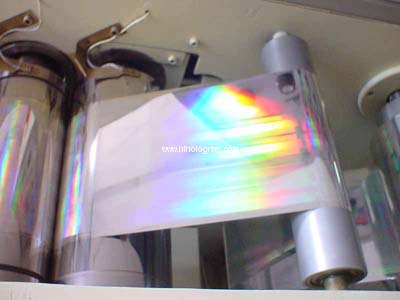
- Metallizing
Step 5: The next step is to load the embossed film roll into a chamber from which the air is removed to create a vacuum. There is an aluminum wire in the chamber which is vaporized by heating it to 2000°F or 1,093°C. The roll is exposed to the vaporized aluminum and in turn another roll is formed and in the process the roll is coated with aluminum. The film is treated to restore moisture lost under the hot vacuum condition, after it is removed from the vacuum chamber. Another coating of lacquer is applied to the film and this creates a surface that can be imprinted with ink. The roll of film is again sliced into narrower rolls.
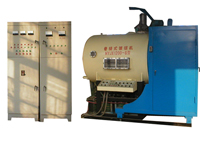
- Converting
Step 6: There can be another step depending on what type of film was used and what kind of product is being made. For example, to give strength, the film can laminated to paper board. The film is given desired shapes for the final product. It can be printed with messages. Pressure-sensitive adhesive is applied to the back of holograms which can be later fixed to other objects or used as stickers.
- Finishing
Step 7: For marketing, the final holograms are either fixed to other products or are packaged for shipment.
3D Hologram Printing Effects
Information reference source from Hologram supplier and www.IHMA.org
The various types of 3D hologram printing effects are as follows:
- 3D Hologram: The effect is the creation of depth on an otherwise flat surface. This hologram is accomplished by generating enough image information which leads the viewer to see the 3D effect. Typically, this requires atleast 12 images of the object, recorded in a strictly defined manner.
- 3D Hologram flips: This is considered to be the simplest of all animation effects. Here, an image changes or flips from one image to the next. A flip allows up to three or more separate images to be combined and viewed independently when viewed at different angles while moving the lens.
- 3D Hologram zoom: This effect allows an image appearing to move closer or farther away in a sequence of animated positions. The effect works best when the background is common throughout for all the animated images. This effect has been designed with a looping of the image.
- 3D Hologram morph: The Morph effect allows changes of one image to another image through the use of sophisticated image algorithms. Although technologically any two objects can be morphed, it however works best when the two images are similar in shape and has a common background.
- 3D Hologram full motion video: This effect uses multiple frames of an action which shows movement from the beginning till end. It is similar to watching a movie clip, but on a medium that requires no power. This effect is best obtained when the background remains constant throughout the sequence.
- 3D Hologram combination: The effect is created by utilizing two or more of the animated effects. For example, a zoom with full motion or a 3D image with a flip background.
3D Hologram products
3D holograms are three dimensional images, produced by capturing a laser light interference pattern on film. 3D holograms are created by interweaving the layered graphics of one complete master image. The special 3D effects are formed by printing graphics in register on the backside of a special lens material which is usually 0.015 to 0.030 inches thick. They produce a truly stunning rainbow or true color hologram of real depth and clarity. These holograms are highly popular for promotional programs when used as magnetic cards, peel and stick labels, buttons, post card, tags, posters etc.
 Material Types for 3D Holograms
Material Types for 3D Holograms
3D holograms basically comprises two main material types-heavy gauge and fine gauge. The difference between the two is in the viewing distance. As the material is a lens, the thicker the lens the greater the viewing distance and hence the difference.
- Heavy gauge: Heavy gauge tend to be used in those applications, which have larger viewing distances. They need slower printing and finishing methods because the lens thickness restricts on the printing method.
- Fine gauge: Fine gauge tend to be used in those applications for closer viewing distances. They are able to be printed through printing presses that allow very good economy of scale.
Features of 3D holograms
A unique feature of the 3D holograms is the "parallax". Parallax means the ability to see a scene and colors from many angles and depths. The colorful effect comes from micro structures within the hologram, which leads to diffraction of the light hitting them.
Another feature of 3D hologram is the complex optical patterns that it contains. The patterns contain information about the depth and photographic appearance of the image.
3D Hologram Printing Effects
The various types of 3D hologram printing effects are as follows:
- 3D Hologram: The effect is the creation of depth on an otherwise flat surface. This hologram is accomplished by generating enough image information which leads the viewer to see the 3D effect. Typically, this requires atleast 12 images of the object, recorded in a strictly defined manner.
- 3D Hologram flips: This is considered to be the simplest of all animation effects. Here, an image changes or flips from one image to the next. A flip allows up to three or more separate images to be combined and viewed independently when viewed at different angles while moving the lens.
- 3D Hologram zoom: This effect allows an image appearing to move closer or farther away in a sequence of animated positions. The effect works best when the background is common throughout for all the animated images. This effect has been designed with a looping of the image.
- 3D Hologram morph: The Morph effect allows changes of one image to another image through the use of sophisticated image algorithms. Although technologically any two objects can be morphed, it however works best when the two images are similar in shape and has a common background.
- 3D Hologram full motion video: This effect uses multiple frames of an action which shows movement from the beginning till end. It is similar to watching a movie clip, but on a medium that requires no power. This effect is best obtained when the background remains constant throughout the sequence.
- 3D Hologram combination: The effect is created by utilizing two or more of the animated effects. For example, a zoom with full motion or a 3D image with a flip background.
3D Hologram products
Fine gauge
- 3d Hologram Retail Products
- 3d Hologram Mouse pads
- 3d Hologram Coasters
- 3d Hologram Post car
- 3d Hologram Business cards
- 3d Hologram Posters
- 3d Hologram Self Adhesive
- 3d Hologram Vending Machine Signs
- 3d Hologram Book/CD, DVD covers Covers
- 3d Hologram Collecreference Cups
- 3d Hologram Direct Marketing u 3d Hologram Promotional
- 3d Hologram Shelf Strips
- 3d Hologram Fine Art prints
- 3d Hologram Counter
- 3d Hologram Fridge Magnets
- 3d Hologram Point of Purchase
- 3d Hologram Clothing Tags
- 3d Hologram Card Holders
- 3d Hologram Packaging
- 3d Hologram Phone cards
Display Holograms, security hologram, Prmtinal Hologram, Holographic Packaging Material, Lenticular Hologram, 3D Hologram, Holographic Machinery, Medical Holography, Hologram Musepad, Holographic TV, Hologram Pouch, Scratch Holograms, Holographic Wads, Digital Hologram, Holographic Bookmark, Holographic Barcode Labels, Hologram Glasses, Hologram Printer, Holographic Button, Hologram Jewelry, Holographic Coin, Holographic Keychain, Holographic Shrink Sleeves, Holographic Bard,
Company: Shanghai Henglei Hologram Co.,LTD(security hologram sticker Supplier)
Address: Room 3001, Building 9, Rui Hong xing cheng, #133 LinPing Bei Road, (Near Subway Line 4, Hualun Rd Stop),Shanghai City, 200086, China
Tel/Fax: 0086-21-61236144 (David song) Or please send email to Mr.song
E-mail: service@hlhologram.com
Contact Person: Mr.David Song(Marketing Manager)
E-mail:zxsong@hlhologram.com Davidsong968@hotmail.com


